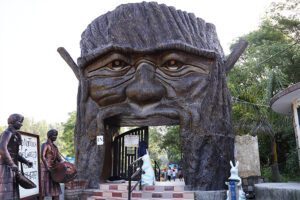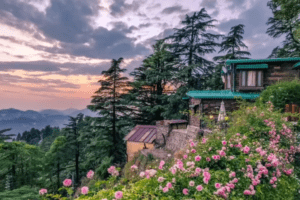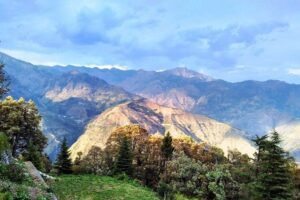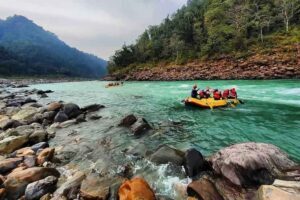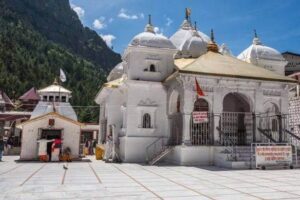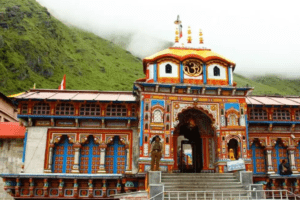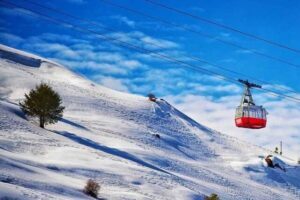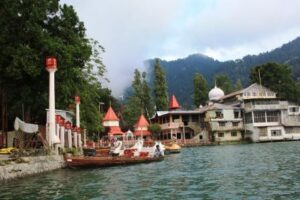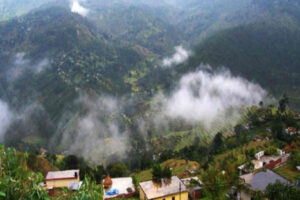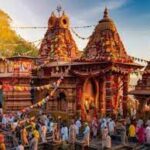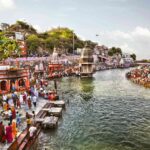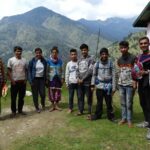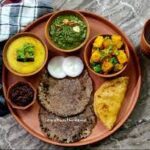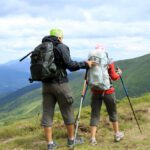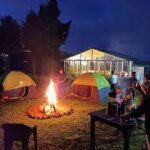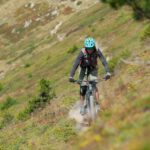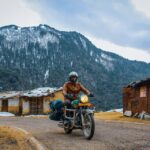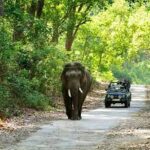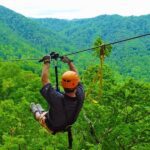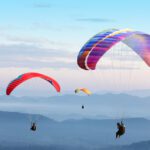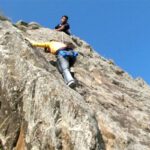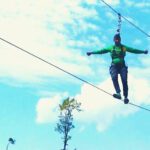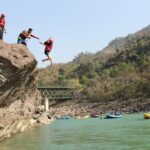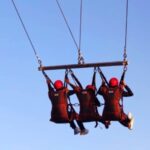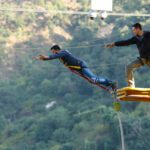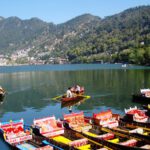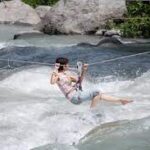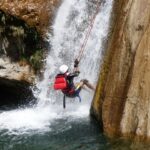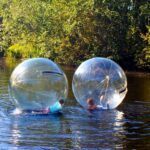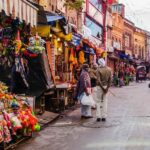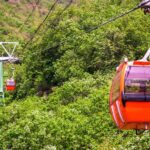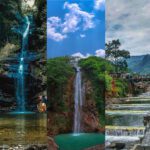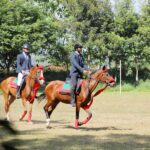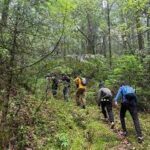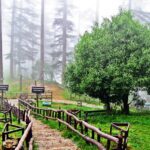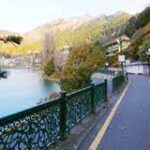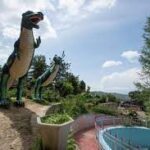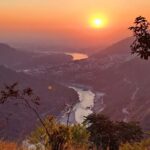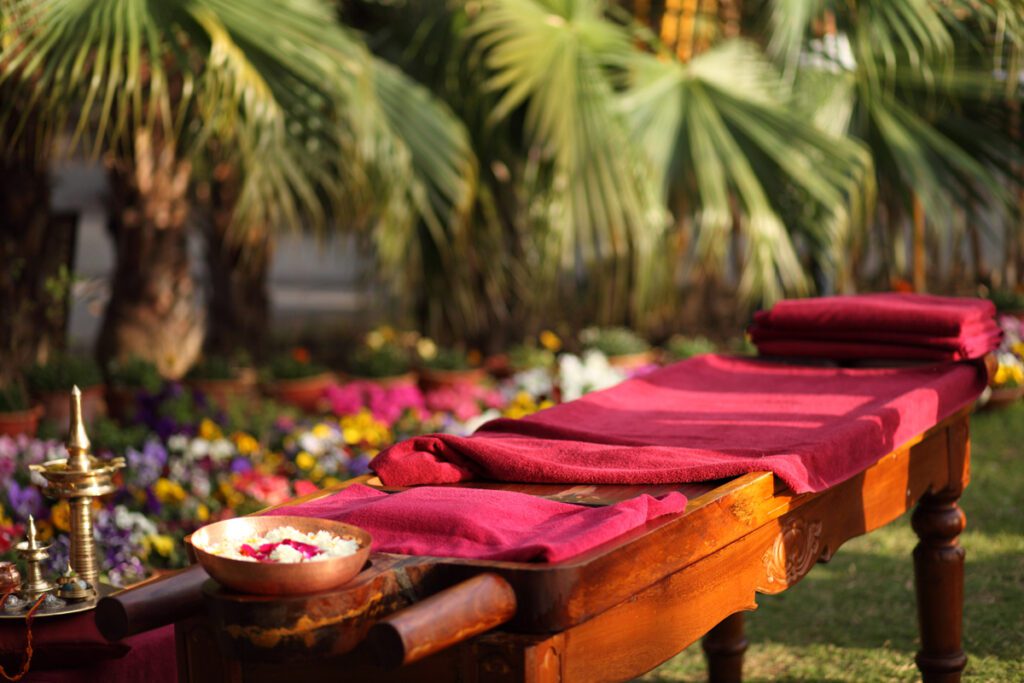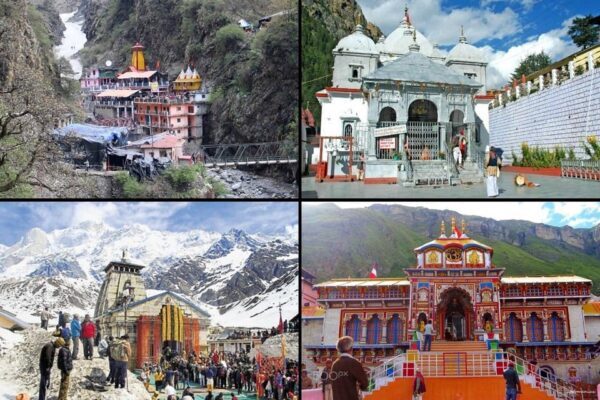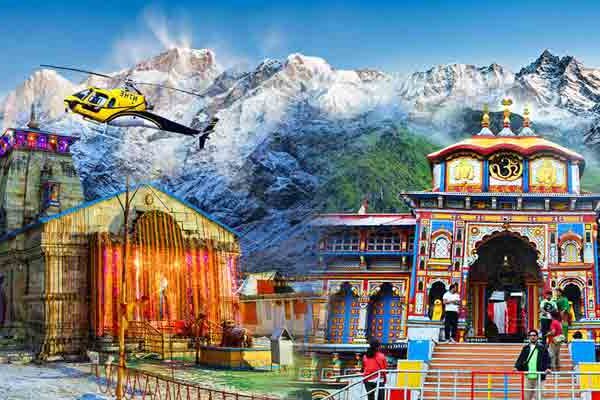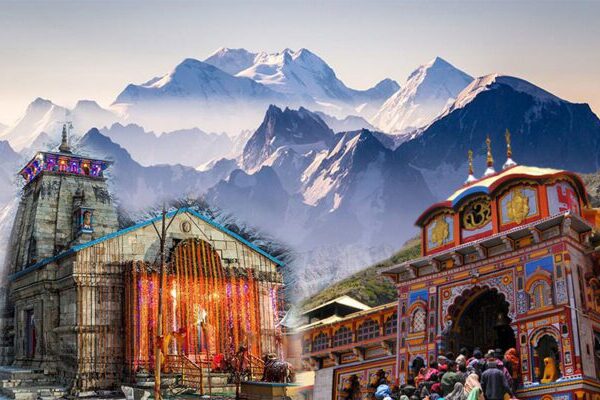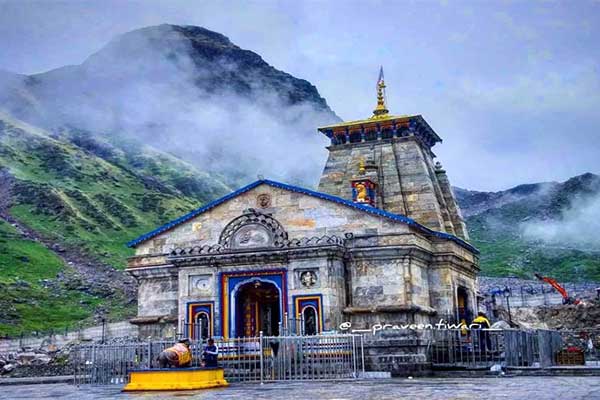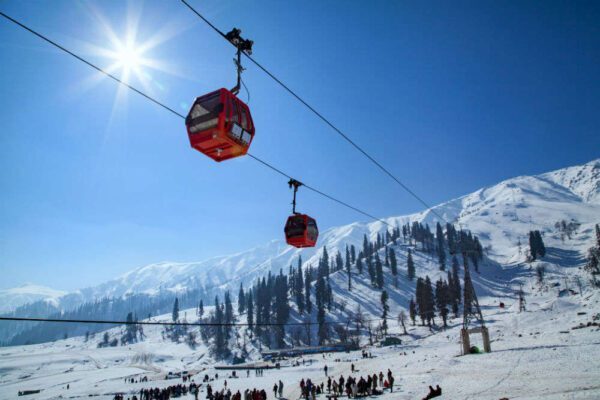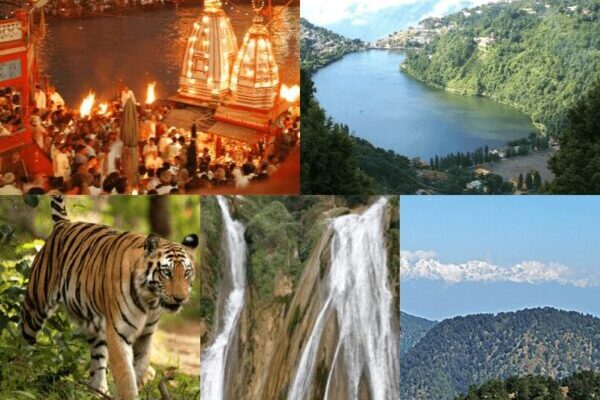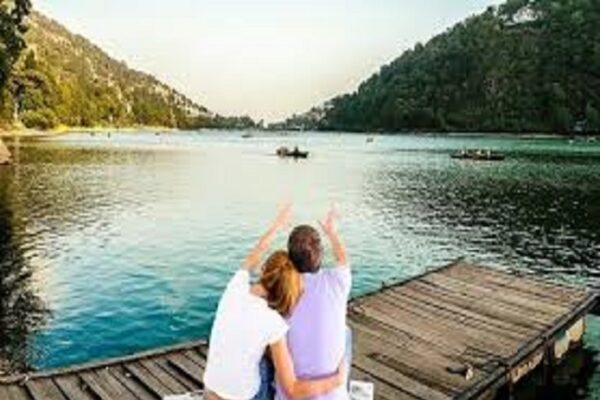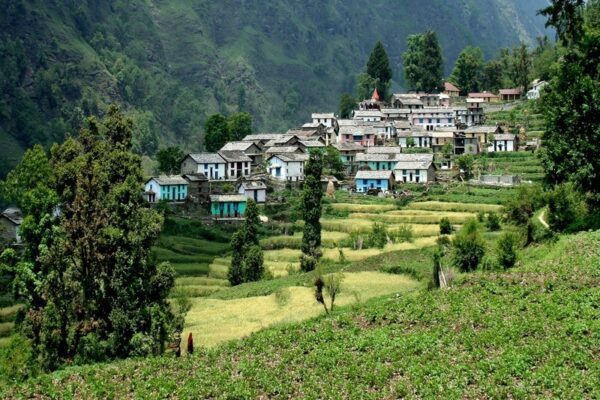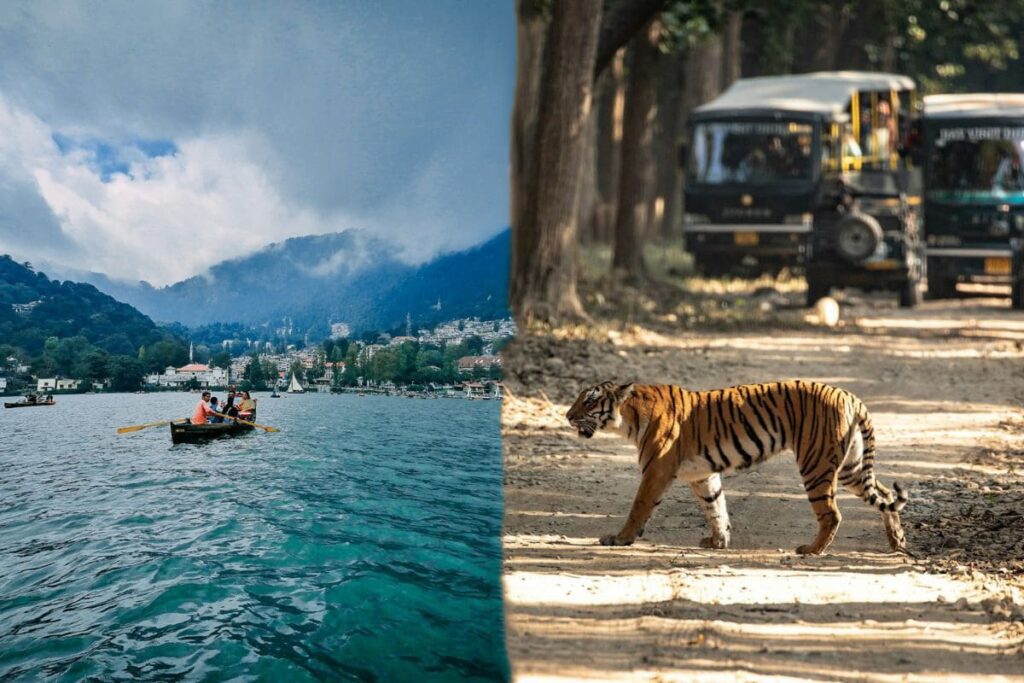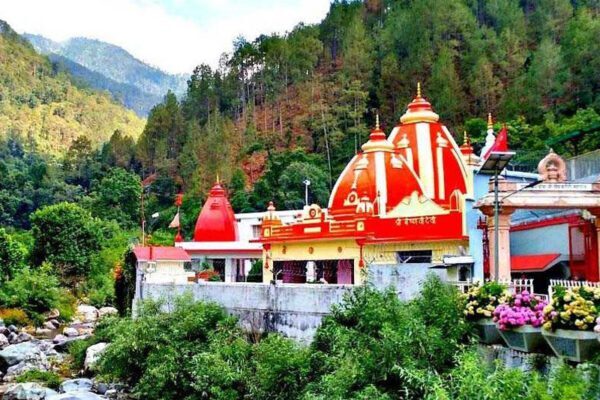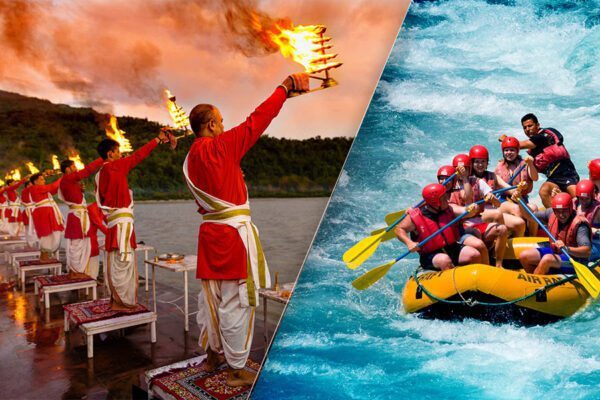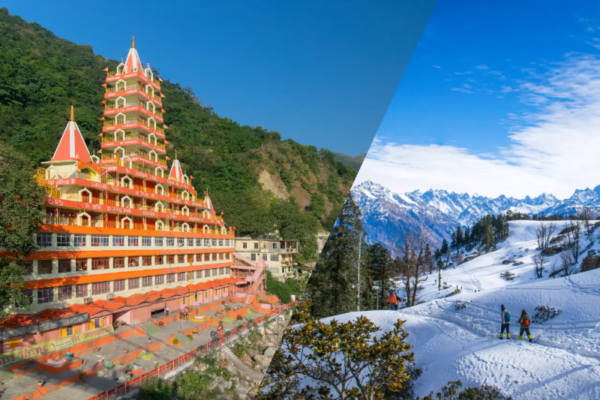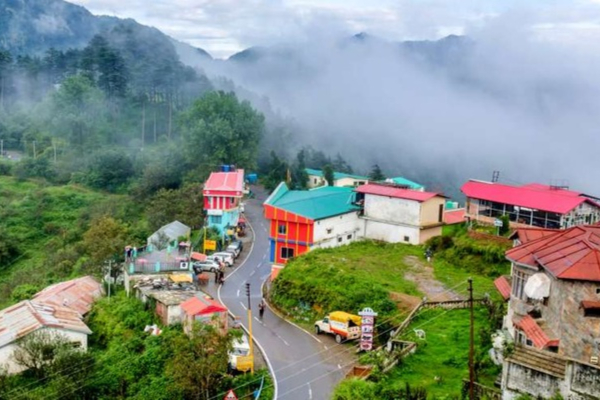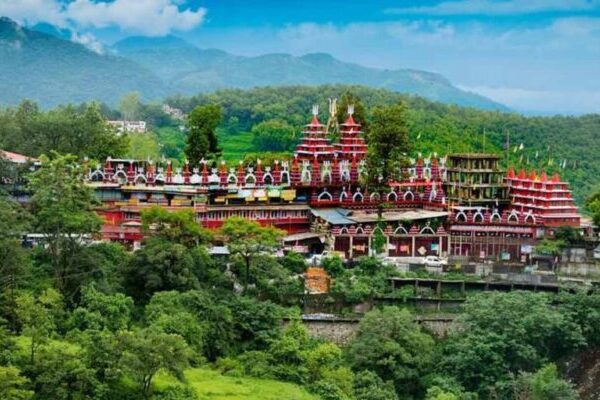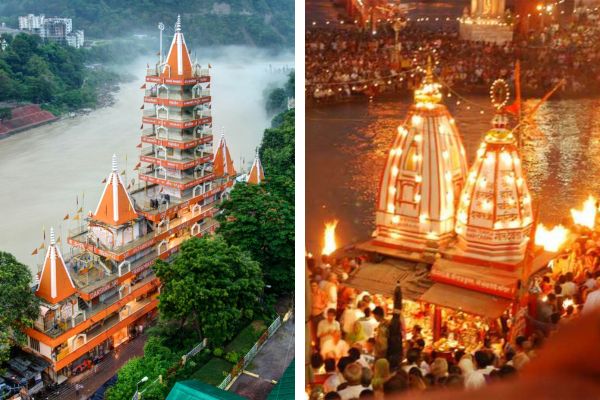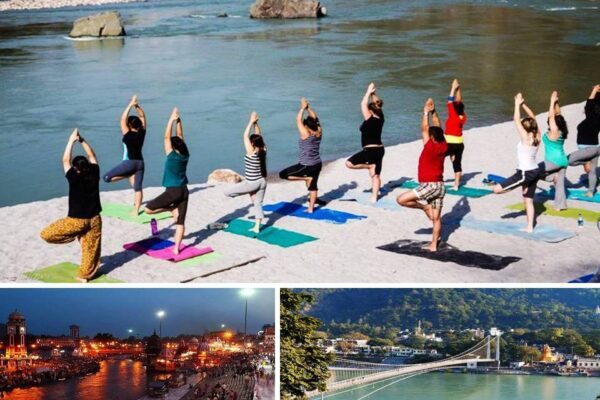
Uttrakhand
Uttarakhand which is famously referred as “Dev Bhoomi” translating to “the Abode of Gods” is stunningly beautiful state in the Himalayas of North India and shares its border with Tibet autonomous Region of China to the northeast, Nepal to the southeast, Uttar Pradesh to the south and southwest, Himachal Pradesh to the northwest. It is divided into two divisions the Garhwal in the west and the Kumaon in the east. The Garhwal has seven districts which consists of Dehradun, Haridwharidwarar, Tehri Garhwal, Pauri Garhwal, Chamoli, Uttarkashi and Rudraprayag while the Kumaon has six districts which consists of Nainital, Almora, Champawat, Bageshwar, Udham Singh Nagar and Pithoragarh. Both the divisions have their own charms. The largest city of the state, Dehradun is the winter capital, while Gairsain, a town in the Chamoli region, was designated as the summer capital in March 2020. The state covers an area of about 53,566 square kilometres out of which a total of approximately 35,651 square kilometres of land area is covered in forests with the majority of pine and oak forests.
Garhwali and Kumaoni are the local languages of Uttarakhand whereas Hindi is the most widely spoken language. English is also spoken in some parts but is not so common.
The history of Uttarakhand dates back to the Stone Age. Here, the civilization began with the settlement of the Kol tribe which later joined forces with the Indo-Aryan khas tribe from the Northern region during the Vedic period. It was the most suitable residence for both Sadhus and Rishis. There is a legend that Pandavas from the epic Mahabharta travelled to Uttarakhand. Later, this area was ruled by a number of dynasties, including the Kunindas (2nd century BC), Naga (4th century), Gupta (7th and 14th century), Katyuri (7th and 14th century), Chandas dynasty, and others.
In the year 1791, the Nepalese Gurkha Empire conquered Almora, the seat of the Kumaon kingdom and in 1803 they also became successful in capturing the Garhwal kingdom. In the 19th century, the Britishers came to war against the Gurkhas. After the Anglo-Nepalese war, this region was ceded to the British as part of the Treaty of Sugauli and the erstwhile Kumaon Kingdom along with the eastern region of Garhwal Kingdom was incorporated with the Ceded and Conquered Provinces. Later, the Garhwal kingdom was re-established in the form of Tehri as a princely state.
After Independence of India, the princely state of Tehri got merged back into the state of Uttar Pradesh with composition of Garhwal and Kumaon regions in Uttarakhand. After that, other political movements emerged and started clamoring for an absolutely distinct state. As a result, Uttarakhand split off from 13 districts in northern Uttar Pradesh on November 9, 2000 to become India’s 27th state. Dehradun was designated as the state capital of Uttarakhand. The initial name of the state was Uttaranchal which was renamed to Uttarakhand in 2006.
Uttarakhand is a culturally colourful society that distinguishes them from the rest of the throng. Its thriving culture is based on moral principles, traditional beliefs, the simplicity of human nature, and a rich mythology. The traditional dress for men is Dhoti or Churidar Pajamas with kurta, long silk overcoat, Jawahar topi or gol topi and Bhotu, while for women is Ghagra–Choli with odni, rangwali Pichora (veil) and Sarees further enhanced by Nath (the big Nose rings) and Galoband. It is also well known for wood carving, rambaan by using jute and hemp, and peeth murals.
The cultural uniqueness of Uttarakhand is also reflected in local music and dance. The state’s most famous folk dances are Langvir Nritya, Barada Nati, Chancheri and Pandav Nritya that are performed at local festivals and special occasions. Uttarakhandi celebration is incomplete without the folk songs Basanti, Mangal which is sung during the marriage ceremony, Jhumeila, Chhopati and Chounphula, which are often accompanied by musical instruments like dhol, bhankora, thali and dholki. Numerous regional fairs and festivals are celebrated by locals alongside the main fairs and festivals. Ghee Sankrant, Harela, Bhitauli, Jagars, and Pandav Nritya are a few of these celebrations. One of the festivals’ highlights is the Pandav Nritya and the Jagars. The people of Uttarakhand hold a belief in both gods and spirits (ghosts). During the Doli ceremony, many individuals have seen the gods’ might in action. Sometimes, people invoke god to find a solution to a specific issue, and to appease the gods, they also sacrifice the goats and sheep.
The dishes of Uttarakhand are simple and locally grown without being dominated by complex spices. Some of the most delicious mouth-watering specialities of Uttarakhand are Buckwheat (locally called kuttu or kotu), Dubuk, Bhatt ki Chutkani, Kadhi (Jhoi or Jholi), Kaafuli, Urad dal ke pakode, green vegetables, Tuasu, Gulgula, Bal mithai and many more.
Alpine musk deer is the state animal, Himalayan monal is the state bird and Brahma Kamal is the state flower of Uttarakhand.
The state of Uttarakhand is surrounded with high snow-capped peaks, lakes, waterfalls, stunning natural scenery, and lovely valleys. Additionally, it is also home to the pilgrimage sites as well as two biggest and the most important rivers the Ganges and the Yamuna. The state has thirteen national parks and wildlife sanctuaries. Jim Corbett National Park, Rajaji National Park, Nanda Devi National Park, and Govind Wildlife Sanctuary are some of the well-known national parks and wildlife sanctuaries. Dehradun, Mussorrie, Rishikesh, Haridwar, Nainital, Dhanaulti and Auli are some of the famous destinations in Uttarakhand for domestic and foreign tourists. It also offers adventure tourism activities like River Rafting, Trekking, Camping, Skiing, Jeep safari and much more that make a lifelong memory.
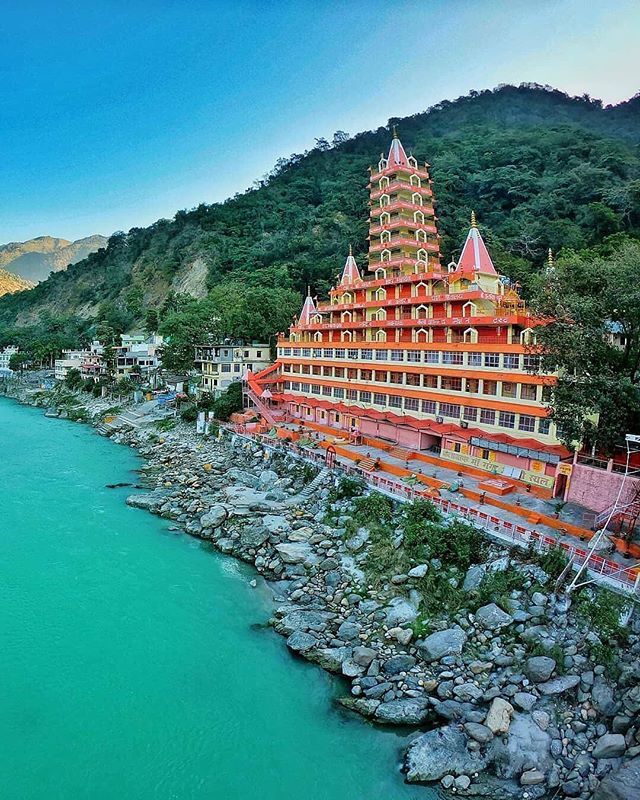

Commonly referred to as the “Land of the Gods,” Uttarakhand is a breathtaking northern Indian state that nestled in the Himalayas. It boasts majestic snow-capped peaks, serene lakes, and lush forests, making it a paradise for nature lovers and adventure seekers. The region is well known for its spiritual significance, home to holy pilgrimage sites like Haridwar, Rishikesh, Badrinath, Kedarnath and Hemkunt sahib. To experience trekking, river rafting, and skiing in scenic locales, adventure enthusiasts draw to Uttarakhand. Uttarakhand provides the ideal balance of peace, spirituality, and adventure with its diverse landscapes and rich culture.
1. Dehradun – The capital city of Uttarakhand
Dehradun is the capital and the largest city of Uttarakhand, which is situated at the altitude of 1480 feet above sea level in the Doon Valley on the foothills of the Himalayas, nestled between the Song river (a tributary of Ganga) on the east and the Asan river (a tributary of Yamuna) on the west.
The city was also mentioned in the two great epics Ramayana and Mahabharata. It is believed that Lord Rama and his brother Laxmana visited this location following defeating Ravana. On the other hand, it is also asserted that this area was the birthplace and residence of Dronacharya, the mythical Royal guru of the Kauravas and Pandavas. There have been nearly 2000-year-old temples and idols discovered in the surrounding locations.
Dehradun’s name is a combination of the words “dera,” which means “home,” and “doon,” which refers to the valley that is situated between the Shivalik Mountains and the Himalayas. The beautiful surroundings, fine weather, and clean air of this city are well known for their beneficial effects on health.
Dehradun is the gateway to the well-known hill station of Mussoorie, Chakrata and the holy cities of Haridwar and Rishikesh.
Dehradun is known as the ‘Educational Hub of Uttarakhand’ due to the presence of prestigious boarding Schools like The Doon School, Welham boys’ School and Institutions like the Forest Research Institute, the Indian Military Academy. Additionally, it provides a variety of experiences, including water sports, bungee jumping, paragliding, and trekking. One can buy the famous Basmati rice, woollen goods, handicrafts and souvenirs in the market of Dehradun.
Along with traditional festivals such as Holi, Janmashatmi, Dussehra, Diwali, and other, some important regional fairs and festivals held throughout the year in Dehradun are Jhanda Fair, Tapkeshwar Fair, Bissu Fair, Laxman Sidh Fair, Mahasu Devta’s Fair, Shaheed Veer Kesari Chandra Fair and Lakhawar Fair.
Dehradun is well–connected by Airway, Railway and Roadway. Jolly Grant Airport is the nearest airport to the city of Dehradun which is located about 27 km away; it is served by flights from Delhi. Dehradun Railway Station is the nearest station to the city that is well connected by train with Delhi, Mumbai, Ujjain, Varanasi, Amritsar and some others. It is also well-connected by roads with all major cities of India and one can easily reach desired destinations through state-run and private buses, Local taxis/cabs and own vehicles.
Dehradun is located around 34 Km from Mussoorie, around 43 Km from Rishikesh, around 57 Km from Haridwar, around 140 Km from Uttarkashi, around 171 Km from Chandigarh, around 175 Km from Rudraprayag, around 180 Km from Ambala, around 223 Km from Shimla, around 250 Km from Delhi and around 282 Km from Nainital. The major tourist attractions in Dehradun are:-
|
|
|
|
|
|
|
|
|
|
|
|
|
|
|
|
|
|
|
|

2. Mussoorie – The Queen of the Hills
Mussoorie is a well-known glistening hill station in the Dehradun district of Uttarakhand state, the muse of a romantic, haven for loners , and a nature lover’s heaven. It is situated atop a horseshoe-shaped mountain crest at an average elevation of 2,005 metres (6,577 ft) above sea level. This hill station offers tranquil waterfalls, colonial architecture, vibrant markets, the Himalayan snow peak to the north-east, and spectacular views of the underlying Doon Valley and Shivalik ranges to the south. The name of Mussoorie derived from the Mansoor plant that thrives in great abundance in this region.
Mussoorie was established by a British Captain Frederick Young and the resident Superintendent of Revenues F. J. Shore at Dehradun in 1825. The British authorities went there in the summer to get away from the heat. During the 1959 Tibetan Rebellion, the 14th Dalai Lama’s central Tibetan administration was initially created in Mussoorie, before being relocated to its current location in Dharamshala, Himachal Pradesh. The first Tibetan school was founded in Mussoorie in 1960.
Mussoorie is renowned not only for its breathtaking natural beauty but it has a significant hub of business and education. The Lal Bahadur Shastri National Administration, which trains officers for the Indian Administrative Service (IAS) and the Indian Police Service (IPS), is another reason for its fame.
Additionally, it provides some options for shopping and adventure; visitors can go horseback riding, take a leisurely stroll across Camel’s Back Road, or ropeway ride upto the top of Gun Hills. This hill station also serves as a gateway to the two sacred destinations, the Yamunotri which is the origin of River Yamuna and the Gangotri which is the origin of River Ganga.
There are several fairs and festivals such as Phool Dei, Harela, Bikhauti, Olgia, Uttarayani, the Bhadraj Fair, summer festival, and autumn festivals that are celebrated with great fanfare and opulence. Markets of Mussoorie provide the opportunity to purchase woollen apparels, accessories, souvenirs, lamps and wooden items.
Jolly Grant Airport is the nearest airport at Dehradun, which is located at a distance of about 61 Km from Mussoorie. Dehradun Railway Station is the nearest station from Mussoorie (around 35 km) that is well connected by train with Delhi, Mumbai, Ujjain, Varanasi, Amritsar and some others. It is also well-connected by roads with all major cities of India and one can easily reach desired destinations through state-run and private buses, Local taxis/cabs and own vehicles. One can opt for the flight or train upto Dehradun then take local taxi/cab or bus from the outside of airport or railway station to reach Mussoorie that will take around 1 to 2 hours.
Mussoorie is located around 34 Km from Dehradun, around 75 Km from Rishikesh, around 88 Km from Haridwar, around 202 Km from Chandigarh, around 215 Km from Ambala, around 254 Km from Shimla, around 285 Km from Delhi and around 320 Km from Nainital. The major tourist attractions in Mussoorie are:-
|
|
|
|
|
|
|
|
|
|
|
3. Landour – British Raj-era hill station
Landour is a stunning hill station about 300 metres (984 ft) above Mussoorie, which was Cantonment town in British India. It is encircled by dense deodar trees, draped in the soothing red colour of rhododendrons and allure of scenic Himalayas. The tranquil environment and immaculate natural beauty of Landour gives off a reassuringly upbeat energy. The name of Landour is derived from Llanddowror which is a tiny village in southwest Wales.
Landour and Mussoorie collectively were referred to as the Queen of the Hills and were regarded as twin towns. Unlike Mussoorie, this hill station offers a wonderful background that is less crowded, charming, and breathtaking. At the time of independence, Landour had twenty-four dwellings; it still has that many today. In a very fitting phrase, someone said, “Choubis Makaan aur Char Dukaan- Itna hi hai Landour.”
Landour is home to some famous figures and authors, including the renowned author Ruskin Bond, Vishal Bhardwaj, who has a vacation property next to Bond’s house, and Prannoy and Radhika Roy, the founders of NDTV, also have a Vacation home here.
Jolly Grant Airport is the nearest airport at Dehradun, which is located at a distance of about 61 Km from Landour. Dehradun Railway Station is the nearest station from Landour (around 34 km) that is well connected by train with Delhi, Mumbai, Ujjain, Varanasi, Amritsar and some others. It is also well-connected by roads with all major cities of India and one can easily reach desired destinations through state-run and private buses, Local taxis/cabs and own vehicles. One can opt for the flight or train upto Dehradun then take local taxi/cab or bus from the outside of the airport or railway station to reach Landour that will take around 1 to 2 hours.
Landour is located around 8 Km from Mussoorie, around 38 Km from Dehradun, around 80 Km from Rishikesh, around 92 Km from Haridwar, around 210 Km from Chandigarh, around 220 Km from Ambala, around 258 Km from Shimla, around 287 Km from Delhi and around 347 Km from Nainital. The major tourist attractions in Landour are:-
|
|
|
|
|
|
|
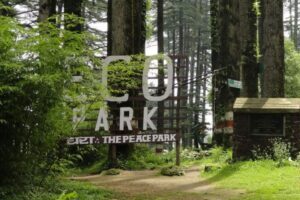
4. Dhanaulti – Tiny hideaway tranquillity hill station
Dhanaulti is a picturesque and serene hill station situated in the Tehri Garhwal district of Uttarakhand at an altitude of about 2286 metres (7500 ft) above sea level. This peaceful hill station is densely covered with the velvety rhododendron, deodar, and tall oak forests.
According to history, prior to India’s independence, Dhanaulti was a princely state located in the Tehri Garhwal region. King Sudarshan Shah ruled it from 1815 until 1849 using Tehri as his capital. Residents of this area were involved in the Quit India Movement and took an active part in the freedom struggle. Additionally, the populace rose up in rebellion against Tehri Riyasat’s king. The district was eventually combined with the Indian state of Uttar Pradesh after they were successful in winning their independence from the Maharaja following the uprising. The district of Tehri Garhwal was incorporated into the newly created state of Uttarakhand following the division of Uttar Pradesh in 2000.
Dhanaulti offers the long wooded slopes, pleasant weather, refreshing crossing breeze, and scenic views of the lofty Himalayas that entice tourists. It is yet unexplored and emerging as a substitute for the overcrowded Dehradun and Mussoorie. In addition, Dhanaulti also provides a variety of adventurous activities such as trekking, mountain biking, valley crossing and camping.
Jolly Grant Airport is the nearest airport at Dehradun, which is located at a distance of about 51 Km from Dhanaulti. Dehradun Railway Station is the nearest station from Dhanaulti (around 36 km) that is well connected by train with Delhi, Mumbai, Ujjain, Varanasi, Amritsar and some others. It is also well-connected by roads with all major cities of India and one can easily reach desired destinations through state-run and private buses, Local taxis/cabs and own vehicles. One can opt for the flight or train upto Dehradun then take local taxi/cab or bus from the outside of the airport or railway station to reach Dhanaulti that will take around 1 to 2 hours.
Dhanaulti is located around 38 Km from Dehradun, around 58 Km from Mussoorie, around 70 Km from Rishikesh, around 82 Km from Haridwar, around 207 Km from Chandigarh, around 215 Km from Ambala, around 260 Km from Shimla, around 284 Km from Delhi and around 307 Km from Nainital. The major tourist attractions in Dhanaulti are:-
|
|
|
|
|
|
|
5. Chakrata – Veritable Treasure
Chakrata is a picturesque hill station encircled by the snow-capped Himalayan peaks, a thick forest of oaks, red rhododendron, and conifers. It is situated in Uttarakhand’s Dehradun district at a height of 2118 metres (7000 feet) above sea level. Formerly known as Jaunsar Bawar, Chakrata was a small village belonging to the Jaunsari Tribe.
Chakrata has a history from the epic Mahabharat. It is stated that when the Kauravas attempted to burn their cousin brother Pandavas alive in Lakshagraha (a house built of Lac material), they escaped by a tunnel that led to Chakrata. Hence, there is a location known as Lakha Mandal. It was later developed by Britishers and used as the East India Company’s high ranking officers’ summer retreat. Chakrata is currently a military cantonment with restricted access, making it extremely difficult for foreigners to visit.
This hilly town is a haven for nature lovers, trekkers, wildlife enthusiasts and bird watchers who can take benefit from nature’s hidden treasures and beauties. It is also a fantastic place for those who want to do nothing but enjoy the splendour of the sun. The forest around Chakrata boasts a wide variety of flora and fauna which is the natural habitat of numerous wildlife species including spotted deer, wild fowls and panther. In addition, Chakrata provides chances for adventure sports like trekking, camping, mountain climbing, skiing, and rappelling.
The Bissu Fair is celebrated by the Jaunsari tribe of Chakrata sub district/Tehsil for a week in the month of March and April to show the gratitude for a good harvest season and pray to the god Santoora Devi who is the reincarnation of goddess Durga and offer her rhododendron flowers. During this fair, people of the Jaunsari tribe dress up in vibrant traditional clothes, singing and dancing to folk music.
Jolly Grant Airport at Dehradun is the nearest airport which is located at a distance of about 115 Km from Chakrata. Dehradun Railway Station is the nearest station from Chakrata (around 88 km) that is well connected by train with Delhi, Mumbai, Ujjain, Varanasi, Amritsar and some others. It is also well-connected by roads with all major cities of India and one can easily reach desired destinations through state-run and private buses, Local taxis/cabs and own vehicles. One can opt for the flight or train upto Dehradun then take local taxi/cab or bus from the outside of the airport or railway station to reach Chakrata that will take around 3 to 4 hours.
Chakrata is located around 82 Km from Mussoorie, around 87 Km from Dehradun, around 133 Km from Rishikesh, around 147 Km from Haridwar, around 185 Km from Ambala, around 240 Km from Patiala, around 250 Km from Shimla, around 290 Km from Chandigarh and around 324 Km from Delhi. The major tourist attractions in Chakrata are:-
|
|
|
|
|
|
|
|
|
|
|
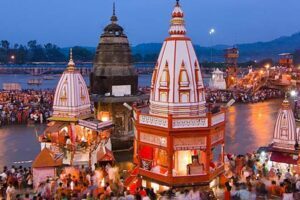
6. Haridwar – The Gateway to Gods
Haridwar is a renowned ancient pilgrimage site in the Haridwar district of Uttarakhand which is situated on the banks of the Ganges River, at the foothills of the Shivalik ranges. It is the place where Ganges River enters the Indo-Gangetic Plains after flowing 250 km from its origin Gomukh. This holy town serves as an entrance to the Dev Bhoomi and four holy temples Yamunotri, Gangotri, Kedarnath and Badrinath (collectively known as Chardham) of the Himalayas.
Haridwar is composed of the terms “Hari,” which means “God,” and “Dwar,” which means “Gate.” The translation literally means “gateway to god.” It is mentioned as Mayapuri, Gangadwar, and Mokshadwar in several old Indian texts.
According to mythology, the King Bhagiratha brought the Ganges River down from heaven to earth with the aid of Lord Shiva, by performing penance, to lift the curse of a sage named Kapila and provide salvation to his ancestors. This ancient custom is still carried out by thousands of Hindu devotees who bring the ashes of their deceased family members in hope of their salvation by the holy water of Ganges River.
It is said that during the Samudra Manthan drops of elixir (Amrit) poured over from the pitcher (kumbha) in Haridwar along with Ujjain, Nasik and Prayagraj. Later on, this was demonstrated by the largest Hindu fair, known as the “Kumbh Mela,” which is held in one of the four locations every three years.
Emperor Vikramaditiya is believed to have constructed Har-ki-Pauri Ghat in the 1st century BC in memory of his brother, Bhratuhari, who came to Haridwar to meditate by the river and died there. According to Legends, Lord Vishnu visited Har-ki-Pauri and left his footprint in a stone wall, giving rise to its name meaning,’ Footsteps of God”. It said that Haridwar is blessed by the presence of all three major Gods of Hindus namely Brahma, Vishnu, Maheshwar.
Haridwar has numerous temples and ashrams with intriguing legacies. In addition to its religious significance, Haridwar is also a centre for learning various arts, cultures and science. Haridwar is well known as a great source of Ayurvedic medicines and herbal cures as well as it is home to the unique Indian tradition of educating ‘Gurukuls’. Furthermore, it has developed into a significant industrial township in Uttarakhand since the district’s Integrated Industrial Estate was established by a state government agency, drawing numerous significant industrial firms that are establishing manufacturing facilities there.
Haridwar is the place where people from all over the world visit for pilgrimage and take a holy dip into the holy Ganges River. Every evening, Ganga Aarti is held at the Har-ki-Pauri and thousands of devotees from all parts of the country come together to pray to Ganga River and float Diyas and marigold flowers.
There are great shopping areas in Haridwar from where one can also buy souvenirs, pooja items such as well-crafted copper and brass idols, colourful glasses, cane baskets, rudraksh, ayurvedic medicines, and so on.
Alcohol and non-vegetarian meals are prohibited here due to its status as a religious centre.
Kumbh Mela is a popular fair which is held once in every twelve years in Haridwar with tremendous pomp and fervour. During this fair, a number of devotees from across the globe visit here and bathe in the holy water. The other main festivals celebrated with great enthusiasm are Kanwar Mela, Somwati Amavasya Mela, Ganga Dussehra and Kartik Poornima.
Jolly Grant Airport is the nearest airport at Dehradun, which is located at a distance of about 38 Km from Haridwar. Haridwar Railway Station is the nearest station from Haridwar city (around 6 km) that is well connected by train with Delhi, Dehradun, Mumbai, Ujjain, Varanasi, Amritsar and some others. It is also well-connected by roads with all major cities of India and one can easily reach desired destinations through state-run and private buses, Local taxis/cabs and own vehicles.
Haridwar is located around 20 Km from Rishikesh, around 51 Km from Dehradun, around 83 Km from Mussoorie, around 177 Km from Ambala, around 213 Km from Delhi, around 222 Km from Chandigarh, around 228 Km from Haldwani, around 250 Km from Kedarnath, around 260 Km from Rudraprayag, around 275 Km from Shimla, around 314 Km from Badrinath and around 365 Km from Agra. The major tourist attractions in Haridwar are:-
|
|
|
|
|
|
|
|
|
|
|
7. Rishikesh – The World Capital of Yoga and Meditation
Rishikesh is an ancient pilgrimage town on the banks of the holiest river Ganges in Dehradun District of Uttarakhand, nestled at an altitude of around 356 metres (1168 ft) in the foothills of the Himalayas. It is the abode of sages and saints who meditate here in pursuit of enlightenment. The sacred city is the entryway of Garhwal Himalayas and beginning point for the Chardham destinations, which include Gangotri, Yamunotri, Badrinath, and Kedarnath. In September 2015, Rishikesh and Haridwar were declared by the Indian Minister of Tourism as the first “Twin National Heritage cities”.
Rishikesh is popularly referred to as the ‘Yoga capital of the world’. Every year during the month of March a one-week long International Yoga Festival (IYF) is organised here by Uttarakhand Tourism Development Board.
Rishikesh was once a part of the mythical Kedarkhand (the present day Garhwal). It is connected to numerous legends and mythological tales. As per one legend states that Raibhya Rishi, the great Hindu saint, performed prolonged penance on the banks of river Ganges. As reward to the saint’s penance Lord Vishnu appeared in front of him as ‘Hrishikesh’, which means the god of senses. Therefore, the place gained popularity by the name of Hrishikesh and was later renamed as Rishikesh.
While as per another legend states that Lord Rama meditated deeply here in order to defeat Ravana, the demon king of Lanka, and it was here that Lakshmana, the younger brother of Rama, used a jute rope bridge to cross the powerful river. However, the original bridge was eventually replaced in 1889 by an iron rope suspension bridge, and in 1986, a bridge akin to it was constructed, known as Ram Jhula. After being devastated by a flood in 1924, the Lakshman Jhula bridge was replaced with a new structure.
Rishikesh has numerous famous ancient temples, Ghats and ashrams. Some ashrams are globally esteemed as hubs of philosophical studies, yoga and traditional Indian healing practices, such as Ayurveda. In addition to its religious and wellness significance, it offers a lot of thrilling adventure activities such as mountain biking, bungee jumping, trekking, camping, rappelling, white water rafting and others. Every evening, Ganges Aarti is organised at Triveni Ghat or Parmarth Niketan where thousands of devotees from all over the nation gather to pray to goddess Ganga and offer leaf bowls which are filled with little oil lamps and flowers.
There are also great shopping areas in Rishikesh from where one can also get precious and semi precious stones, astrological gems, Rudraksha, idols of Deities, clothes, souvenirs, Jewellery, spiritual books, Ayurvedic products, and etc. Alcohol and non-vegetarian meals are prohibited here due to its status as a religious centre.
Jolly Grant Airport is the nearest airport at Dehradun, which is located at a distance of about 22 Km from Rishikesh. Rishikesh Railway Station is the nearest railway station from Rishikesh (around 4 km) but it is not connected to other major cities apart from Haridwar, Delhi, Lucknow and Mumbai. It is also well-connected by roads with all major cities of India and one can easily reach desired destinations through state-run and private buses, Local taxis/cabs and own vehicles. One can opt for the flight or train upto Dehradun then take local taxi/cab or bus from the outside of the airport or railway station to reach Rishikesh that will take around 30 to 40 minutes.
Rishikesh is located around 20 Km from Haridwar, around 44 Km from Dehradun, around 70 Km from Dhanaulti, around 75 Km from Mussoorie, around 193 Km from Ambala, around 230 Km from Kedarnath, around 237 Km from Chandigarh, around 238 Km from Delhi, around 240 Km from Rudraprayag, around 242 Km from Haldwani, around 267 Km from Shimla, around 295 Km from Badrinath and around 426 Km from Agra. The major tourist attractions in Rishikesh are:-
|
|
|
|
|
|
|
|
|
|
|
|
|
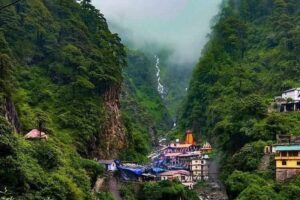
8. Yamunotri – The Seat of Goddess Yamuna
Yamunotri is the source of River Yamuna in Uttarkashi District of Uttarakhand, nestled at an altitude of around 3293 metres (10804 ft) on the western side of Garhwal Himalayas. The holy place offers breathtaking vistas of snow-capped peaks and verdant valleys. It is a part of the Chota Char Dham pilgrimage circuit including Gangotri, Kedarnath and Badrinath that holds enormous significance for Hindu devotees and attracts pilgrims from all over the world.
River Yamuna originates from Champasar Glacier which is about one kilometre upstream from the riverbed close to Yamunotri temple. It is the second most sacred river of India and is a part of the three renowned sister rivers – the Ganga, the Yamuna and the Saraswati.
According to religious legends, Goddess Yamuna is the daughter of Surya Dev (the Sun God) and Devi Sandhya (the goddess of consciousness) and is sister of Yama Deva (the god of death). It is believed that bathing in the sacred Yamuna River atones for all sins and shields against untimely or agonising death.
Another legend states that Yamunotri was the hermitage of the sage Asit Muni, who used to bathe daily both in the River Ganges and the River Yamuna but as he became old, he was unable to travel to Gangotri. Realising his problem, a stream of the Ganges River appeared opposite Yamunotri for him.
The Yamunotri temple was constructed by the monarch of Tehri, Sudarshan Shah in the honour of Goddess Yamuna in 1839. The shrine was severely damaged in two major earthquakes of 1923 and 1982. But in the later part of the nineteenth century, it was repaired and renovated with the initiative of Maharani Guleria of Jaipur.
Like the Gangotri temple, the Yamunotri temple closes on Diwali every year,and the idol of Goddess Yamuna is transported in a palanquin to the village of Kharasali. During the April/May celebration of Akshaya Tritiya, the temple is opened and an idol is returned to the temple followed by elaborate rituals and Vedic chants.
Apart from religious beliefs, it provides a variety of cultural and adventure experiences, such as trekking, camping and village tours where travellers can visit local villages and gain insight into their way of life. The festivals of Basant Panchami, Phool Dei and Olgia are celebrated at the Yamunotri apart from the other major festivals.
Yamunotri does not have its own dedicated airport and railway station but if travellers prefer to travel by train or air, then Jolly Grant Airport in Dehradun is the nearest airport to Yamunotri, approximately 200 km away. The nearest railway station to Yamunotri is Dehradun railway station at a distance of about 175 km and it is well connected by train with Delhi, Mumbai, Ujjain, Varanasi, Amritsar and some others. Travellers can take a local taxi/cab or bus from outside the airport or railway station to Hanuman Chatti and then commence trekking of around 14 km to reach Yamunotri. There are ponies, dandies and kandies facilities are also available, if someone does not want to go on foot. Yamunotri does not have direct road access. Janki chatti is well connected by roads with Dehradun, Rishikesh, Barkot and Uttarkashi, and one can go there through state-run and private buses, Local taxis/cabs and own vehicles. Travellers can also be hired by helicopter from Dehradun to Yamunotri.
Yamunotri is located around 188 Km from Dehradun, around 228 Km from Gangotri, around 235 Km from Rishikesh, around 247 Km from Haridwar, around 250 Km from Devprayag, around 262 Km from Rudraprayag, around 278 Km from Ambala, around 355 Km from Kedarnath, around 415 Km from Badrinath, around 430 Km from Delhi and around 462 Km from Haldwani. The major tourist attractions in Yamunotri are:-
|
|
|
|
|
|
|
9. Gangotri – The Source of Holy River Ganga
Gangotri, the origin of River Ganges, is a renowned pilgrimage town on the banks of the sacred Bhagirathi River in Uttarkashi District of Uttarakhand, nestled at an altitude of around 3100 metres (10200 ft) in the Garhwal Himalayan Range. The holy town is encircled by the snow-capped peaks, verdant forests and gorgeous scenery. It is a part of the Chhota Chardham pilgrimage circuit including Yamunotri, Kedarnath and Badrinath.
The Ganges River originates at Gaumukh in Gangotri Glacier which is about 19 km away from Gangotri town and is reachable by trekking. The river is known at its source as Bhagirathi, and it takes on the name Ganga from Devprayag onward, where it merges the Alaknanda River.
As per legend states that Goddess Ganges took the form of a river in order to grant salvation to ancestors of king Bhagiratha, after his severe penance and to lessen the force of the River Ganges’ intense flow, Lord Shiva received her into his hair.
The stone on which king Bhagiratha is said to have worshipped lord Shiva, to bear the descent of River Ganga, is situated close to the Gangotri temple.
Another legend states that the Pandavas carried out the “Deva Yagna” at the Gangotri temple to atone for the deaths of their relatives and fellow warriors after defeating the Kauravas in the Mahabharata conflict.
The Gangotri temple was constructed by a Gorkha General Amar Singh Thapa in the early eighteenth century and was later renovated by the king of Jaipur in the twentieth century.
In addition to its religious significance, it provides some options for adventure activities such as trekking, camping and skiing on Garhwal Himalayas. There are many local fairs and festivals that are celebrated by people of Gangotri with tremendous fervour and excitement. Akshaya Tritiya, Diwali and Ganga Dussehra are some of the popular festivals in Gangotri. Ganga Dussehra is held in the months of May-June to commemorate the divine descent of the Ganga on to this earth.
Every year on Diwali, the Gangotri temple closes, and the idol of Goddess Ganges is moved to Mukhyamath temple, which is situated in the village of Mukhba. During the April/May celebration of Akshaya Tritiya, the temple is opened. The temple is beautifully decked on this special day, and an idol is returned to the temple followed with procession and dance.
The Gangotri Temple closes on Diwali every year and the idol of Goddess Ganga is shifted/ transported to the Mukhyamath temple, located in the Mukhba village. The temple opens on the occasion of Akshaya Tritiya held in the months of April / May. During this occasion, the temple is decorated lavishly and an idol is taken/ brought back to the temple followed with procession and dance.
Gangotri does not have its own dedicated railway station or airport but if travellers prefer to travel by train or air, then Jolly Grant Airport in Dehradun is the nearest airport to Gangotri, approximately 266 km away. The nearest railway station to Gangotri is Dehradun railway station at a distance of about 237 km and it is well connected by train with Delhi, Mumbai, Ujjain, Varanasi, Amritsar and some others. Travellers can take a local taxi/cab or bus from outside the airport or railway station to reach Gangotri that will take 8 hours. Travellers can also be hired by helicopter from Dehradun to Gangotri. It is also well-connected by roads with all major cities of India and one can easily reach desired destinations through state-run and private buses, Local taxis/cabs and own vehicles.
Gangotri is located around 228 Km from Yamunotri, around 241 Km from Dehradun, around 265 Km from Rishikesh, around 290 Km from Haridwar, around 252 Km from Devprayag, around 270 Km from Rudraprayag, around 357 Km from Kedarnath, around 386 Km from Ambala, around 421 Km from Badrinath, around 501 Km from Delhi and around 504 Km from Haldwani. The major tourist attractions in Gangotri are:-
|
|
|
|
|
|
|
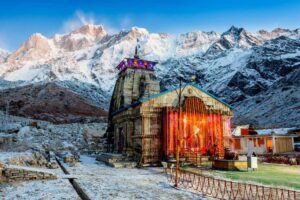
10. Kedarnath – Dedicated to Lord Shiva
Kedarnath is a sacred town in Rudraprayag district of Uttarakhand, nestled in the Garhwal Himalayas at an altitude of around 3583 metres (11755 ft) near Chorabari glacier which is the source of the Mandakini River. The town is surrounded by breathtaking snow-capped peaks and valleys covered with grassy meadows. Along with Gangotri, Yamunotri and Badrinath, it is one of the four main pilgrimage destinations in Uttarakhand known as Chota char-dham Pilgrimage. The town was severely damaged in June 2013 by the Uttarakhand state’s Flash Floods, which were brought on by extremely heavy rainfall.
Kedarnath is named after king Kedar who ruled this region during the Satya Yuga. Lord Shiva, the protector and destroyer, is also known by the name Kedar. The former name of this region was Kedar Khand.
One of Lord Shiva’s twelve Jyotirlingas in India, the well-known Kedarnath temple welcomes thousands of devotees every year. The beautiful architecture of the temple is more than a millennium and is built from evenly shaped huge grey stone slabs.
Legend has it that the ancient temple was built by the Pandavas brothers from the epic Mahabharata. After the Kurukshetra War, Pandavas felt guilty of having killed their own cousins Kauravas and relatives, and embarked on a pilgrimage to meet Lord Shiva for redemption. But the Lord Shiva hid repeatedly and took refuge at Kedarnath in the form of a bull. The Lord dived into the ground, leaving his hump on the surface at Kedarnath. The remaining portions of Lord Shiva appeared at four other places -the arms of the Lord appeared at Tungnath, the face at Rudranath, the belly at Madmaheshwar and his locks (hair) at Kalpeshwar. Those are now known as the Panch Kedar. Eventually, however, Lord Shiva did pardon them. In the eighteenth century A.D., the present shrine was established by Adi Shankaracharya adjacent to the site of an earlier temple.
The town is rendered uninhabitable by the massive snowfall that falls there during the winter. The palanquin of Kedarnath is moved to Ukhimath, while the people of Kedarnath relocate to villages situated at lower elevations. The temple is open only for six months from May to November. Kedarnath also offers a variety of adventure activities, including rock climbing, camping, and trekking.
Kedarnath does not have its own dedicated railway station or airport but if travellers prefer to travel by train or air, then the nearest airport to Kedarnath is Jolly Grant Airport situated at a distance of about 249 km. Rishikesh Railway Station is the nearest railway station to Kedarnath at a distance of about 230 km but it is not connected to other major cities apart from Haridwar, Delhi, Lucknow and Mumbai. On reaching the airport or railway station one can take a taxi/cab or bus from the outside of the airport or station. Gaurikund is the nearest road point to Kedarnath approximately 16 km and well connected by roads with Rishikesh, Dehradun, Haridwar, Srinagar and other nearby cities. Travellers can reach Gaurikund through state-run and private buses, Local taxis/cabs and own vehicles, and can also be hired by helicopter from Dehradun, Gauchar, Agastyamuni, Guptkashi or Phata to Kedarnath.
Kedarnath is located around 188 Km from Dehradun, around 262 Km from Rudraprayag, around 230 Km from Badrinath, around 230 Km from Rishikesh, around 250 Km from Haridwar, around 355 Km from Yamunotri, around 357 Km from Gangotri, and around 430 Km from Delhi. The major tourist attractions in Kedarnath are:-
|
|
|
|
|
|
11. Badrinath – Dedicated to Lord Vishnu
Badrinath is an ancient sacred town in the Chamoli district of northeastern Uttarakhand, lies at an altitude of around 3100 metres (10170 ft) in the Garhwal Himalayas ranges along the banks of Alaknanda River close to India-Tibet border. It is encircled by the Nilkantha peak, the twin mountain ranges of Nara and Narayan, and has immense mythological significance. It is a part of the Chota Char Dham pilgrimage circuit along with Gangotri, Yamunotri and Kedarnath that is extremely important for Hindu devotees and attracts pilgrims from all over the world.
Badrinath gets its name from Badri, a kind of wild berry that formerly flourished there in abundance. The magnificence of this holy town is mentioned in numerous ancient texts and scriptures.
As per religious legends, the twin forms of Lord Vishnu, Nara and Narayana, meditated at Badrinath. It is also thought that the Pandavas passed via Badrinath on their way to paradise.
Another legend states that the Mahabharata was written by the sage Vyasa at a cave located in Mana, approximately 4 kms away from Badrinath.
Badrinath is well –known for Badrinath temple that is home to Lord Badrinarayan, an incarnation of Lord Vishnu. It is thought that in the eighth century, saint-philosopher Adi Shankaracharya established the current temple. Adi-shankra found a Shaligram idol of Lord Badrinarayan in the Alaknanda riverbed. He erected this idol in a cave close to Tapt Kund. Later, in the sixteenth century, the monarch of Garhwal moved it to the current temple.
The temples of Puri, Rameswaram, and Dwarka form the Char Dhams, together with the shrine of Badrinath.
The area gets the massive snowfall that falls there during the winter. The temple is open only for six months from May to November. Badrinath also offers a variety of adventure activities like trekking, camping and mountaineering in the Garhwal mountain ranges.
Badrinath does not have its own dedicated railway station or airport but if travellers prefer to travel by train or air, then Jolly Grant Airport in Dehradun is the nearest airport to Badrinath situated at a distance of about 300 Km. Rishikesh Railway Station is the nearest railway station to Badrinath at a distance of about 285 km but it is not connected to other major cities apart from Haridwar, Delhi, Lucknow and Mumbai. It is also well-connected by roads with all major cities of India and one can easily reach desired destinations through state-run and private buses, Local taxis/cabs and own vehicles. One can opt for the flight upto Dehradun or train upto Rishikesh then take local taxi/cab or bus from the outside of the airport or railway station to reach Badrinath that will take around 8 hours. Travellers can also be hired by helicopter from the Sahastradhara helipad, Dehradun to Badrinath.
Badrinath is located around 41 km from Joshimath, around 153 Km from Rudraprayag, around 230 Km from Kedarnath, around 291 Km from Rishikesh, around 316 Km from Haridwar, around 328 Km from Dehradun, around 333 Km from Haldwani, around 415 Km from Yamunotri, around 421 Km from Gangotri and around 552 Km from Delhi. The major tourist attractions in or nearby Badrinath are:-
|
|
|
|
|
|
|
|
|
|
|
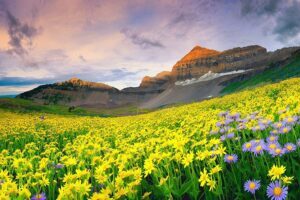
12. Valley of Flowers – Nature’s Colourful Symphony
Renowned for its meadows of rare alpine flowers and the variety of flora, the Valley of Flowers is a well-known tourist destination which is situated in Chamoli District of Uttarakhand at an altitude of around 3600 metres (11800 ft). It is spread over an area of 87.50 sq. km. and has more than 600 species of flowers such as poppies, orchids, marigolds, primulas , daisies and anemones. Every year hundreds of tourists and botanical researchers visit this scenic place.
Initially known as Bhyundar Valley, this valley was discovered and renamed by Mountaineer Frank S. Smith in 1931. This gracious Valley of flowers was designated a National park in 1982 and listed in the UNESCO World Heritage Site in 2004 for its wild untamed blooms encircled by snowy peaks.
According to the Hindu epic Ramayana, Lord Hanuman brought Sanjivani (the magical herb) from the Valley of flowers to the ailing brother of Lord Rama, Lakshmana. As per locals , it is the fairies’ playground, and they descend to the valley when no one else is present. Currently, the national park is closed to both grazing and habitation.
The serene Valley of flowers complements the untamed mountain range of Nanda Devi National Park to the east. Collectively, they encompass a unique transition zone between the Great Himalayan and Zanskar mountain ranges. Valley of Flowers and Nanda Devi National Park, together, form the Nanda Devi Biosphere Reserve.
Apart from a collection of different colourful flowers and alpine shrubs, this place is also known for milky white streams, snow-clad peaks and pristine air. It is also a home to snow leopards, musk deer, red foxes, black bears and many more.
Valley of Flower does not have its own dedicated railway station or airport but if travellers prefer to travel by train or air, then the nearest airport to Valley of Flower is Jolly Grant Airport situated at a distance of about 290 Km. Rishikesh Railway Station is the nearest railway station to Valley of Flower at a distance of about 280 km but it is not connected to other major cities apart from Haridwar, Delhi, Lucknow and Mumbai. On reaching the airport or railway station travellers can hire a taxi/cab or take a bus from the outside of the airport or station. Govindghat is the nearest road point to the Valley of flowers approximately 15 km. Travellers can reach Govindghat through state-run and private buses, local taxis / cabs and own vehicles then can start trekking towards the Valley of flowers. Recently, Helicopter service has also been started between Govindghat and Ghangaria which is the nearest point to the Valley of flowers.
Valley of Flowers is located around 15 km from Govindghat, around 22 Km from Joshimath, around 40 Km from Badrinath, around 144 Km from Rudraprayag, around 234 Km from Kedarnath, around 281 Km from Rishikesh, around 307 Km from Haridwar, around 318 Km from Dehradun, around 368 Km from Paonta Sahib and around 520 Km from Delhi. The major tourist attractions in and nearby Valley of Flowers are:-
|
|
|
|
|
|
|
13. Auli – The Ski Resort of India
Dotted with snowy peaks, oak and coniferous forests, Auli is a beautiful scenic hill station in Chamoli district of Uttarakhand situated at an altitude of around 2900 metres (9500 ft) above sea level in the Garhwal Himalayas. It is known as Auli Bugyal in Garhwali which means ‘Meadow’. It is renowned for its smooth ski tracks and fertile ground for adventure that attracts a large number of tourists. Numerous endangered plant and animal species can be found here, such as the Himalayan Musk Deer, Snow Leopard, and Blue Poppy.
In the eighth century, the great guru Adi Shankaracharya is said to have come to Auli and constructed math at Joshimath. This location is now known as Shankaracharya Tapasthali.
In the past, Auli was a major hub for trade, and the semi-nomadic Mongolians and Bhotias tribes regularly travelled its paths as they engaged in centuries-long barter trade with Tibet. The Himalayan snow-capped mountains were crossed with the assistance of their horses and long-haired yaks.
In addition, Auli offers numerous adventure sports and heartwarming activities like camping, trekking, skiing, snowboarding and cable car ride. The Uttarakhand Tourism Department organises the annual Auli Skiing Festival in the winter months to promote skiing in India. Moreover, Auli also hosts the National skiing and winter sports Championships run by the Winter Games Federation of India in January and February. The Garhwal Mandal Vikas Nigam (GMVN) offers skiing courses for beginners and experts in Auli, and they run from December to March for seven to fourteen days.
There is very little to shop in Auli. If someone really wants to take home gifts for family and friends, they have to go to Joshimath market which is around 13 km away to buy a variety of souvenirs and handicrafts such as jewellery, winter apparel, etc.
The slopes of Auli were the training ground for the Indo-Tibetan Border Police Force and Indian Paramilitary forces.
Auli does not have its own dedicated railway station or airport but if travellers prefer to travel by train or air, then Jolly Grant Airport is the nearest airport at Dehradun, which is located at a distance of about 272 Km from Auli. Rishikesh Railway Station is the nearest railway station from Auli at a distance of around 255 km but it is not connected to other major cities apart from Haridwar, Delhi, Lucknow and Mumbai. It is also well-connected by roads with all major cities of India and travellers can easily reach their desired destination through state-run and private buses, Local taxis/cabs and own vehicles. Joshimath is the nearest bus station to Auli located at a distance of 10 km. One can opt for the flight or train then take a local taxi/cab or bus from the outside of the airport or railway station to reach Joshimath that will take around 8 hours. From Joshimath, travellers can travel to Auli by cable car.
Auli is located around 10 Km from Joshimath, around 52 Km from Badrinath, around 258 Km from Rishikesh, around 275 Km from Nainital, around 295 Km from Dehradun, around 300 Km from Haldwani, around 493 Km from Chandigarh and around 495 Km from Delhi. The major tourist attractions in Auli are:-
|
|
|
|
|
|
|
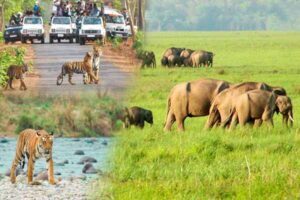
14. Jim Corbett National Park– The second largest Tiger Reserve
The prime wildlife destination for nature lovers and wildlife enthusiasts, Jim Corbett National Park is one of the oldest and most popular National parks in India. It is situated in the Nainital district of Uttarakhand.
The park was established as Hailey National Park in the year of 1936. After India gained Independence, the park was named as Ramganga National Park but in the year of 1956, it was renamed after the renowned author and wildlife conservationist – Jim Corbett who played a major role in its establishment. In 1973, the region was included in Project Tiger, an initiative to save India’s endangered Bengal Tiger.
The Corbett National park is spanned over an area of about 1280 sq.km, of which 822 sq.km forms the core area, the whole area is home to a diverse range of landscapes, from hills and riverine belts to marshy depressions, large lakes and grasslands. The altitude of this park ranges from 1,180 to 3,410 ft (360 to 1,040 m). Jim Corbett National Park is home to Royal Bengal Tigers and a variety of other wild animals such as Elephants, Deer, Chital, Nilgai, Bears, Sambar, Flying fox, Hedgehog and around 580 species of domestic and migratory birds.
Jim Corbett National Park is divided into five different tourism zones, namely, Biljani, Dhika;a, Jhirna, Durgadevi and Dhela. These are the manifested core or buffer areas of the park where visitors can participate in the Wildlife Safari and enjoy the vistas of the verdant forest, dotted with waterfalls and bisected by rivers and streams while on safari. Private cars are not permitted inside the park; only vehicles registered with the government may participate in the Jungle Safari.
Jim Corbett National Park is one of the finest maintained and protected regions in the nation and attracts thousands of Indian and foreign visitors each Year. The best time to visit Jim Corbett National Park would be from November to June while peak seasons are December and May. The park remains closed from July to September due to the rainy season.
Ramnagar railway Station is the nearest railway station from Jim Corbett that is well connected by train with Delhi, Haldwani, Dehradun, Haridwar, Moradabad, Agra, Jaisalmer and other major cities of India. Pantnagar Airport is the nearest airport to Jim Corbett which is located around 86 km away. Travelers from other parts of the country can also opt for the flight upto Delhi and can board a connecting flight to Pantnagar then take local taxi/cab or bus from the outside of the airport to Jim Corbett that will take around 2 hours. It is also well-connected by roads with all major cities of India and one can easily reach desired destinations through state-run and private buses, Local taxis/cabs and own vehicles.
Jim Corbett is located around 52 Km from Haldwani, around 63 Km from Nainital, around 78 Km from Ranikhet, around 156 Km from Rishikesh, around 181 Km from Dehradun, around 222 Km from Delhi, around 337 Km from Chandigarh, and around 383 Km from Agra. The major tourist attractions in Jim Corbett are:-
|
|
|
|
|
|
|
|
|
15. Nainital – The city of Lakes
Nainital is a gorgeous paradisiacal hill station perched at an altitude of around 2084 metres (6837 ft) above sea level in the Kumaon region of Uttarakhand. It gleams like a dazzling pearl amidst the Himalayan Mountains and is surrounded with lakes which are dotted with colourful sailboats and nature’s bounty. The name of Nainital is derived from Naini Lake which is one of the 52 Shakti Peeths.
According to the Hindu mythology, the Goddess Sati’s eyes, or Nain, fell in Nainital when Lord Shiva was bringing her burnt body to Kailash. In the memory of this event, a Naina Devi shrine was constructed where Goddess Shakti is worshipped by the devotees.
Nainital was founded in 1841 by European businessman Percy Barron, a sugar trader from Shahjahanpur. Later on, it became a summer retreat for the British soldiers and colonial officials to relieve them from the intense heat of the plains.
Nainital has gained recognition for its ravishing lake, picturesque view, ancient temples, prestigious educational institutions and schools which have stood since the British era and heritage buildings. Situated on Manora Peak, approximately 10 km away from Nainital, the Observatory or The Aryabhatta Research Institute of Observational Sciences (ARIES) is the hub for astronomical studies and optical tracking of artificial satellites.
There are numerous renowned personalities, who have been associated with Nainital. Legendary Bollywood Actor Amitabh Bachchan as well as actor Kabir Bedi and Dalip Tahil were educated at Sherwood college of Nainital.
Additionally, it offers a number of adventurous activities such as yachting, trekking, boating, parasailing, horse riding, paragliding, rock climbing and more. There are many local markets from where travellers can buy handicraft products such as handmade decorative candles, ornamental pieces, woollen items, bamboo fabric and pine cone decorations.
Nainital celebrates each occasion with gusto and contentment. Uttarayani, Khatarua, Holi, Harela Mela, Phooldei, Nainital Autumn Festival or Sharad Utsav, Gheeya Sankranti or Olgia and Nanda Devi Fair are some of the famous fair and festivals of Nainital.
The most convenient way of reaching Nainital is by road. Travellers can reach there through state-run and private buses, Local taxis/cabs and own vehicles. Nainital is also accessible through train upto Kathgodam which is nearest railway station to Nainital at a distance of around 36 Km and well connected by regular train with Delhi, Dehradun, Agra, Mathura, Lucknow and other major cities of North India. There are several taxis/cabs or buses available from outside the railway station of Kathgodam. Pantnagar Airport is the nearest airport to Nainital which is located around 70 km away. Travellers from other parts of the country can also opt for the flight upto Delhi and can board a connecting flight to Pantnagar then take a local taxi/cab or bus from the outside of the airport to Nainital that will take around 2 to 3 hours.
Nianital is located around 43 Km from Haldwani, around 49 Km from Mukteshwar, around 58 Km from Ranikhet, around 63 Km from Jim Corbett, around 65 Km from Almora, around 236 Km from Haridwar, around 255 Km from Rishikesh, around 292 Km from Delhi and around 279 Km from Dehradun. The major tourist attractions in Nainital are:-
|
|
|
|
|
|
|
|
|
|
|
|
|
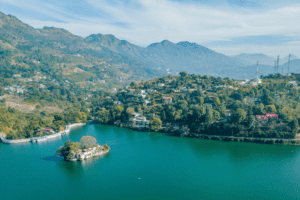
16. Bhimtal – Glittering Lake City
Bhimtal is an idyllic and less-crowded destination in the Kumaon region of Uttarakhand perched at an elevation of 1370 metres (4490 ft) above sea level. Bhimtal appears to be a portal to heaven on earth thanks to its breathtaking views and remarkable perspectives of the grandeur of nature. It is well known for the beautiful lake that is surrounded by verdant mountains and has a little island in the middle that is home to the stunning Aquarium Island Café.
Bhimtal has been named after the most notable character in the epic Mahabharat, Bhima. It is believed that the well-known lake of Bhimtal was formerly known as the ‘Bhima Sarovar Lake’ which used to be the stomping ground of the Pandavas as per the Hindu legends, Bhima and the other brother visited this place during their exile (Vanvas).
This lake city also has a number of sacred temples including an ancient Bhimeshwar Mahadev Temple which was built by Bhima during the Pandavas‘s exile. Later, the shrine was renovated by the king of Kumaon Baz Bahadur of the Chand Dynasty in the seventeenth century.
According to historians, Bhimtal was utilised as a stoppage en route from India to Tibet and Nepal and it may well have been part of the silk route. There are numerous government and private institutions in Bhimtal including Kumaon University Campus, Birla Institute of Applied Sciences, and Tasar Regional Research Center.
Additionally, Bhimtal provides ample opportunities for enthralling activities such as boating, fishing, trekking, camping, water zorbing and paragliding to visitors for fun-filled vacations. There are several small stores from where travellers can buy wonderful wooden craftwork, carpets, statues, Jewelry, Garhwali paintings and handmade candles made by the local artists of Bhimtal.
Many well-known fairs and festivals, including Nandadevi Mela, Basant Panchami, Harela, Makar Sankranti, Maha Shivratri, Phooldei chhamma chhei, and Khatarua, are celebrated in Bhimtal with tremendous fanfare and extravagance.
Bhimtal does not have its own dedicated railway station or airport but if travellers prefer to travel by train or air, then the nearest railway station is Kathgodam at a distance of around 22 km which is well connected by regular train with Delhi, Dehradun, Agra, Mathura, Lucknow and other major cities of North India. There are several taxis/cabs or buses available from outside the railway station of Kathgodam. The nearest airport to Bhimtal is Pantnagar airport which is located around 56 km away. Travellers from other parts of the country can also opt for the flight upto Delhi and can board a connecting flight to Pantnagar then take a local taxi/cab or bus from the outside of the airport to Bhimtal that will take around 2 hours. The most convenient way of reaching Bhimtal is by road. One can reach there through state-run and private buses, Local taxis/cabs and own vehicles.
Bhimtal is located around 24 Km from Nainital, around 29 Km from Haldwani, around 58 Km from Ranikhet, around 65 Km from Almora, around 79 Km from Jim Corbett, around 88 Km from Binsar, around 252 Km from Haridwar, around 271 Km from Rishikesh, around 296 Km from Dehradun and around 300 Km from Delhi. The major tourist attractions in Bhimtal are:-
|
|
|
|
|
|
|
|
|
|
17. Ranikhet – The Cantonment town of the Kumaon region
Ranikhet, literally means ‘Queen’s field or Queen’s meadow’, is a scenic hill station and tranquil cantonment town nestled between the snow clad western peaks of the Himalayas in the Almora district of Uttarakhand at the altitude of 1,869 metres (6132 ft) above sea level.
As per legend, Raja Sudhardev, a Katyuri monarch, won the heart of Queen Padmini of Kumaon, who subsequently chose this hill paradise for her residence, gave it the name Ranikhet. However, the region does not actually have a palace. Ranikhet was established by the British in 1869 as headquarter of Kumaon Regiment, who used the station as a retreat from the intense Indian summer heat. Currently, It is home of the Kumaon Regiment, Naga Regiment and Military Hospital and is maintained by the Indian Army.
Ranikhet is known for being home to one of the highest nine-hole golf courses in Asia and the rolling meadow of the course is captivating. Dotted with ancient temples, colonial buildings and verdant fruit orchards, it provides beautiful vistas of the vast Kumaon Ranges. Furthermore, there are dense forests and tumbling waterfalls that mesmerise tourists with their everlasting beauty. In addition, this hilly town also provides ample opportunities for enthralling activities such as paragliding, birdwatching, fishing, rock- climbing as well as hiking in the foothills of the Himalaya.
Ranikhet is noted for its Kumaoni culture, and along with traditional festivals such as Holi, Diwali and other, some important regional festivals like Phool Dei, Harela and Bikhauti are celebrated with great gusto and contentment. There are a variety of local markets from where travellers can buy honey, jam, pickles, local wine, woolen clothing, copperware and handicraft products such as ringaal, ramban and wooden craft.
There are numerous celebrities, who prefer its tranquil surroundings, including the Tamil film industry’s superstar Rajnikanth is a frequent visitor to Ranikhet and stops here on his route to Dunagiri hills to visit the meditation cave of the sage Maha Avtar Baba.
The most convenient way of reaching Ranikhet is by road. Travellers can reach there through state-run and private buses, Local taxis/cabs and own vehicles. Ranikhet does not have its own dedicated railway station or airport. It is accessible through train upto Kathgodam which is nearest railway station to Ranikhet at a distance of around 75 km and well connected by regular train with Delhi, Dehradun, Agra, Mathura, Lucknow and other major cities of North India. There are several taxis/cabs or buses available from outside the railway station of Kathgodam. Pantnagar Airport is the nearest airport to Ranikhet which is located around 110 km away. Travellers from other parts of the country can also opt for the flight upto Delhi and can board a connecting flight to Pantnagar then take a local taxi/cab or bus from the outside of the airport to Ranikhet that will take around 3 to 4 hours.
Ranikhet is located around 46 Km from Almora, around 58 km from Nainital, around 78 Km from Jim Corbett, around 88 Km from Haldwani, around 157 Km from Pithoragarh, around 210 Km from Munsiyari, around 267 Km from Haridwar, around 287 Km from Rishikesh, around 312 Km from Dehradun and around 348 Km from Delhi. The major tourist attractions in Ranikhet are:-
|
|
|
|
|
|
|
|

18. Pithoragarh – Gateway to the Himalayas, Embrace Tranquillity
Pithoragarh is an idyllic hill station in the northern state of Uttarakhand in India, surrounded by snow-capped peaks, an amazing valley and alpine meadows. It is also blessed with perennial rivers and cascading waterfalls cutting across forests. Perched at an altitude of approximately 1,620 metres (5,330 feet) above sea level, Pithoragarh is often referred to as the gateway to the Himalayas. Pithoragarh, being a border town, serves as a major Indian Army base.
Historically, Pithoragarh has been influenced by various dynasties, including the Chand Dynasty and the Gorkhas, and some remnants of those eras in the region can still be seen today.
Pithoragarh, the third largest town of the Kumaon region, is known for its temples, fort, natural beauty, and cultural importance. Additionally, it offers some activities for adventure enthusiasts and pilgrims such as trekking, hiking, hand gliding and temple walks. In Pithoragarh’s market, tourists can purchase unique Kumaoni handicrafts, clothing and trekking gear.
Pithoragarh Mahotsav, Kandali festival and hilljatra are major festivals that are celebrated with a lot of fervour and sharing the unique culture of Pithoragarh.
The most convenient way of reaching Pithoragarh is by road. Travellers can reach there through state-run and private buses, Local taxis/cabs and own vehicles. Pithoragarh does not have its own dedicated railway station or airport but if travellers prefer to travel by train or air, then the nearest railway station is Tanakpur at a distance of around 147 km and it is well connected with major cities of India. There are several taxis/cabs or buses available from outside the railway station of Tanakpur. The nearest airport to Pithoragarh is Pantnagar Airport which is located around 252 Km away. Travellers from other parts of the country can also opt for the flight upto Delhi and can board a connecting flight to Pantnagar then take local taxi/cab or bus from outside of the airport to Pithoragarh that will take around 6 hours.
Pithoragarh is located around 115 Km from Almora, around 129 Km from Munsiyari, around 157 Km from Ranikhet, around 171 Km from Mukteshwar, around 178 Km from Nainital, around 190 Km from Haldwani, around 250 Km from Jim Corbett, around 476 Km from Delhi and around 488 Km from Dehradun. The major tourist attractions in and nearby Pithoragarh are:-
|
|
|
|
|
|
|
|
|
|
|
|
|
|
|
The destination has an enormous range of things that tourists can experience and explore on tour to Uttarakhand.
- Explore the beautiful Ashram and history at Museums
- Cultural and Religious Experience:-
Seek blessings at the Miraculous Shrines |
Attend Aarti on the banks of the river Ganges |
Take a dip in the holy water |
Take a village tour |
Enjoy local cuisine |
Wear Uttarakhandi dress, and do photography |
- Adventure Activities:-
Trekking and hiking |
Camping with bonfire |
Mountain Biking |
Skiing |
Snowboarding |
Bike Tour |
Wildlife Safari |
Zip Lining |
Paragliding |
Rock Climbing |
Sky Walk |
Cliff Jumping |
Giant Swing |
Bungee Jumping |
- Indulge in Water Sports / Activities:-
Boating at lakes |
River rafting |
River Crossing |
Water Rappelling |
Water Zorbing |
Fishing and angling |
- Practice Yoga and Meditation to Rejuvenate
- Get an Ayurvedic treatment
- Go to the Aquarium on Bhimtal Island
- Stroll through the plantations for a fresh air
- Visit the last village of India
- Explore the exciting Robber’s cave
- Explore the War Memorial’s history
- Admire the magnificent architecture of Forest Research Institute
- Take Sightseeing Tour
- Attend fairs and festivals
- Leisure Activities:-
Go on Shopping spree |
Stroll at the Mall Road |
Take a Ropeway ride |
Visit the stunning waterfall |
Horse riding |
Nature walk |
Picnic at Eco-Park |
Stroll around the lake |
Lakeside Picnic |
Enjoy Ashiyana Park |
Go for a stroll on the enormous golf course |
Explore the Dams |
View an enchanting sunset from the sunset point |
Devbhoomi Uttarakhand is nestled in the lap of the Himalayas, and is known for its scenic beauty, pilgrimage sites and adventure activities that draw attention of people from various parts of India and globe. It is well connected to the rest of the country by airway, railway and roadway, which make accessibility in Uttarakhand extremely easy and convenient.
By Air
Uttarakhand has six domestic airports of which three are main airports and the rest are proposed airstrips for emergency and military purposes. Details of airports are as follows:-
- Jolly Grant Airport – Located in Dehradun approximately 25 Km from the city centre and serves non-stop flights to and from all major cities like Delhi, Mumbai, Bengaluru and Chennai. The airport is a primary airport in Uttarakhand and has close proximity to Haridwar (38 Km/1 Hr), Rishikesh (21 Km/ 35 Min) and Mussoorie (60 Km/ 2 Hrs).
- Pantnagar Airport – Located in Udham Singh Nagar and serves as a gateway to hill stations like Haldwani (27 Km/ 50 Min), Nainital (70 Km/ 2 Hrs 30 Min), Jim Corbett Park (90 Km/2 Hrs), Ranikhet (110 Km/4 Hrs) and Almora (116 Km/ 4 Hrs 15 Min).
- Naini Saini Airport or Pithoragarh Airport – Located in Pithoragarh approximately 5 Km from the city. It is named after Naini Saini who was the social worker of the area.
- Gauchar Airport (also known as Gauchar Airstrip) – Lies on the Char Dham route of Badrinath in small town Gauchar for helicopter services from Dehradun to Gauchar, as well as return flight. Currently it is operated by the Indian army.
- Bharkot Airport (also known as Chinyalisaur Airstrip) – Located in Uttarkashi approximately 35 Km from the town. It remained non-operational for civil services but the Indian Air force uses the airstrip as the Advanced Landing Ground.
- Chaukhutia Airport – It is a new proposed airport near Chaukhutia town in Almora district.
These airports are not well connected with many cities and towns of the country via direct flights. Travellers will need to arrive at Delhi to find connecting flights to other major cities in India. During the winter, flights may be abruptly postponed and cancelled at the last minute because of severe weather conditions. The nearest international airport from Uttarakhand is Indira Gandhi International Airport in Delhi. Upon arrival, travellers can avail hotel shuttle, taxi, car rental or bus as per their convenience from outside the airports to reach their intended destination.
By Train
Uttarakhand has a well connected railway network of 43 railway stations including terminus, junctions and small halts that connects the plain region of Uttarakhand with other cities in the country. Haridwar, Dehradun, Rishikesh, Kathgodam, Rudrapur, Ram Nagar, Lal Kuan, Kotdwar and Pant Nagar are some of the important railway stations in Uttarakhand. Lots of important trains such as Dehradun-Bombay Express, Mussoorie Express, Kathgodam Ranikhet Express, Ujjain Express and more, pass through the state, easing up for tourists to reach close destinations. Upon arrival, travellers can easily avail taxis, buses and car rental from outside these stations to reach their intended destination.
By Road
Road is the best and the most efficient way of travelling to Uttarakhand. The state has a good road network which connects it to the rest of the country through national and state highways. Additionally, there are important district roads that allow travelling to the remotest area of the state. Some roads can also be closed during winter or monsoon due to excessive snowfall or landslides. There are numerous privately-operated buses and state Government-run buses (i.e. Uttarakhand State Road Transport Corporation), from local to Luxury, that ply at frequent or regular intervals from Uttarakhand to neighbouring states such as Delhi, Haryana, Himachal Pradesh, Punjab, and Uttar Pradesh. The major intrastate and interstate bus terminals are located in Dehradun and Haridwar. Travellers from nearby destinations can opt to drive their own vehicle and also hire private cars or Local taxes to reach Uttarakhand.
Uttarakhand has numerous modes of transport to travel within the state that travellers can choose as per their budget, preferences and convenience.
Buses
Buses are quite inexpensive and convenient, and travellers get to see the fascinating scenic beauty and small hamlets and towns while travelling which they might have missed otherwise. Uttarakhand has an excellent bus service system in and around the state, operated by Government-Run Uttarakhand Transport Corporation (UTC). In addition, private operators also cater to the needs of tourists. The buses range from a Volvo, Deluxe, air-conditioned, ordinary to mini and standard buses. Buses are easily available in every city, town, and village, and reach the most remote corners of the state. This remains to be the main mode of mobility for the locals.
Trains
The extension of railways beyond the foothills of the Himalayas, which mostly include the districts of Dehradun, Haridwar, Udham Singh Nagar, and Naintal, remains both impractical and improbable. The train services are few in Uttarakhand because hills make up the majority of the terrain.
Auto Rickshaws
Auto Rickshaws, also called an auto, are available in Uttarakhand, but they have their specific region in which they operate and do not go beyond their region. Travellers can be found autos at almost all Bus Stand, Railway Stations, and at important places. Autos usually charge by the metre and if they charge by unmetered then keep that in mind while choosing it – agree on a fare with the driver before the journey. The fare will depend upon the distance covered.
Cycle and E-Rickshaws
Non polluting cycles and e-rickshaws (electric rickshaw) are available in Dehradun, Haridwar, Nainital and Mussoorie. They are good for short distances or places which are too far to walk but too short for an auto rickshaw/taxi. Cycle and E-rickshaws do not have metres, so decide a fare before hopping in.
Taxis/Cabs
Taxis are one of the most popular modes of transport in Uttarakhand, and are comfortable, convenient, quick and safer than auto rickshaws.This is preferred by travellers when they are alone or going to an unknown destination even though the rates will be higher than auto. They are easily available at the Bus stand, the railway stations, outside most popular hotels and other important places, for traveling to desired destinations. Moreover, most hotels /resorts also arrange a taxi for tourists on request. Taxis are unmetered so ask for the rate and negotiate with the driver before starting the journey.
App-based Cab services such as Uber and Ola Cabs are also available to travel within Dehradun and to nearby cities. These cabs also have operations in Haridwar, Rishikesh, Mussoorie, Haldwani and Nainital. Rides commence at designated points that are marked in their apps. Charges of App-based Cabs have been fixed by their companies.
Rental
Travellers also have an option of renting cars/ motorcycles/ scooty for exploring Utarakhand at their own pace. A number of companies provide motorcycles, scooty/ scooters, e-bikes and cars (both self-driven and chauffeured cars) for rental. Travellers should check out the credibility and past records of the rental companies before hiring vehicles. Rates vary according to the vehicle, the model, the season and how long one wants to rent it. Rules and prices of renting can also vary from company to company. Rental companies can also charge a security deposit and ask for submitting a copy of the driving licence (National or International) and some original ID such as passport, pan card or voter ID which is given back once the vehicle is returned.
Foot
Every place of interest is not possible to cover on foot but a small locality can be explored in detail. Trekking tours are also available to beautiful valleys and explore the hidden jewels of Uttarakhand.
TOUR PACKAGES OF UTTRAKHAND
- 08 Day(s) 07 Night(s)
- 11 Day(s) 10 Night(s)
- 03 Day(s) 02 Night(s)
- 07 Day(s) 06 Night(s)
- 06 Day(s) 05 Night(s)
- 05 Day(s) 04 Night(s)
- 08 Day(s) 07 Night(s)
- 05 Day(s) 04 Night(s)
- 05 Day(s) 04 Night(s)
Inclusions: –
- Domestic Air/ Train Fares as per itinerary.
- Assistance on Arrival.
- Accommodation on double/triple sharing basis with breakfast (Veg) in Haridwar, Rishikesh, Dehradun, Mussoorie, Nainital, Ranikhet, Kausani, Chopta, Joshimath, Devprayag, Nandprayag, Badrinath, Guptkashi, Janki Chatti and Uttarkashi.
- Accommodation on double /triple sharing basis with breakfast (Veg) and dinner (Veg) in Rishikesh under Rishikesh Adventure Tour, Jim Corbett, Ghangaria under Valley of Flower and Hemkund Sahib Yatra and Kedarnath.
- Accommodation on single/ double sharing basis with all meals (breakfast, lunch, evening drink and dinner) as per individual diet plan throughout the wellness tour.
- A child below 5 yrs sharing the same bed with parents will be complementarity (For Accommodation).
- The Private vehicle or shuttle service is available strictly as per the itinerary and not at disposal. (Note: A/c will not run in the Hilly Area.)
- All parking fees, Road taxes, Driver allowance, Fuel and toll charges.
- All entry permits, forest fees and entry charges are included to all sight-seeing points as listed in the itinerary.
- Cable car ride charges to the Mansa Devi temple in Haridwar are included.
- The Rishikesh Adventure tour includes activities like river rafting, camping, body surfing, bonfire, music, and dancing.
- Boat ride on Naini Lake(Nainital Lake) in Nainital on a shared basis.
- The Do Dham Yatra by helicopter includes a sacred VIP Darshan at the temples of Badrinath and Kedarnath.
- Wildlife Safari by Jeep/ Canter/ Elephant at Jim Corbett National Park.
- Experienced trek leader and support staff on Valley of Flower and Hemkund Sahib Trek.
- Consultation with Ayurvedic experts to determine the best Ayurvedic rejuvenation regimen and wellness activities throughout the Wellness tour.
Note: – 1) Package Cost may change during the fairs & festivals time.
2) For Honeymooners:
- One flower decoration, special honeymoon cake, candle light dinner on the day of arrival in Uttarakhand.
- Fruit Basket in the Room.
- Non a/c fresh up room for an hour, if required, in case of arrival is before 7 AM.
Exclusions: –
- International Air/ Train Fares.
- Additional excursions or sightseeing and activities or extra usage of vehicles, other than mentioned in the itinerary.
- Any expenses caused by reasons beyond our control including but not limited to bad weather, natural calamities (landslides, floods), flight delays, excess baggage, rescheduling or cancellations, any accidents, medical evacuations, riots, strikes, war, airline or hotel policies etc.
- Any increase in taxes or fuel price, leading to increase in cost on surface transportation & land arrangements, which may come into effect prior to departure.
- Any portage at airports and hotels, tips, Visa, insurance, Alcoholic and non alcoholic beverages, mineral water, telephone charges and all items of personal nature.
- Hotel early Check-In or Late Check-Out charges, if applicable.
- Meals other than specified in the inclusion.
- Charges for activities at Dhanaulti Adventure Park are not included in the Dhanaulti Tour.
- Cable car or chair lift ride charges at places like Auli, Mussoorie and Nainital are not included.
- Charges for adventure activities such as Bungee Jumping / Giant Swing, Flying fox, Zipline, Sky Cycle, Rope activities, Wall climbing and wall rappelling at Rishikesh are not included.
- Charges for winter adventure sports such as skiing, ice skating, and snowboarding at Auli are not included.
- The expense of hiring a doli/palanquin, helicopter, or mule to visit Valley of Flowers and shrines such as Kedarnath, Yamunotri, Hemkund Sahib is not included.
- Cost of Evacuation in case of an emergency.
- Camera Tickets are NOT INCLUDED in the mentioned cost of Sightseeing & Transfers.
- Compulsory Gala Dinner on X’mas & New year Eve if applicable.
- Any services not specifically mentioned in the inclusions.
- Card surcharge if payment through credit card
- Peak season supplements and charges.
- All applicable government taxes.
- Optional activities mentioned in the itinerary & anything not mentioned in the above packages.
Note: – Inclusion and Exclusion of Customized Trips will be provided on request.
- No strict dress code is enforced at tour sites. However, please be advised to dress accordingly to places and for places of worship; shorts or sleeveless tops are not recommended. Head must be covered with a dupatta, scarf, saree pallu, or handkerchief when entering inside the complex of religious places.
- To avoid last time disappointment booking tickets, accommodation and activities well in advance. Especially during peak season when most flights run full and the price of flights, accommodation and activities get high. It is also necessary to reconfirm flight timings at least 24 hours before departure. If tourists are travelling in winter, flights and trains could be cancelled at the last minute due to difficult weather conditions.
- The hotels/resorts/camps are subject to their availability. If they are not available, the travelers will be accommodated in a property of similar standard.
- In case travellers’ flight arrival is by noon, we need to modify the itinerary.
- We, The Global Trots, retain the right to rearrange the itinerary due to any kind of disruptions that may arise (for example, extreme weather, political turmoil, or others).
- Any rescheduling or rearranging of the package due to situations beyond The Global Trots’ control might invite additional charges for accommodation and/or transportation.
- If a traveler wants to or decides to leave the trip in the midst, the traveler is responsible for any expenditures incurred thereafter. The Global Trots shall not be held liable for such decisions or any refunds.
- A/c will not run in the Hilly Area.
- The list of essential things and must carry items while travelling to Uttarakhand are –
- Warm clothes including socks (Pack warm clothes depending on destination and the month of travel)
- Woolen Hand Gloves
- Comfortable shoes / Trekking Shoes (if planned for trekking)
- Hats or Caps
- Sunscreen Lotion & Moisturising Lotion
- First Aid Box including personal meditation
- Original & copies Id Proofs (Aadhar, PAN, Passport, etc)
- Dark polarized sunglasses
- Camera with sufficient batteries and Memory Card
- Charger and Power banks
- Waterproof jackets and Umbrella for Monsoon trip
- Other necessities
- Where to visit in Uttarakhand and when –
| Name of Places | Famous for | Things to do | Ideal for | Best time to visit |
| Dehradun | Natural Beauty, Education & Institutions, Temples & Spiritual Sites, Litchis , Basmati Rice, Shopping | Visit the Ancient Robber’s Cave, Seek Blessings at Spiritual Sites, Relax at Sahastradhara, Visit Forest Research Institute, Shopping at Local Markets, Trekking, Paragliding, Wildlife Safari at Rajaji National Park | Peace lovers, Honeymooners, Family and Friends, Seeking Blend of Education | Throughout the Year |
| Haridwar | Religious and Spiritual Significance | Ganga Aarti at Har Ki Pauri, Temples & Ashram Visit, Shopping, Ayurveda Treatment, Holi Bath at Various Ghats, Attend the Famous KUmbh Fair | Everyone, whether Friends, Couples, or Families, Seeking a Spiritual Experience. | Throughout the year |
| Rishikesh | Religious and Spiritual Significance, Adventure Sports, Yoga & Meditation | Yoga & Meditation , Nature Walks, Trekking, Hiking, Explore Spiritual Sites, Indulge in White River Rafting and other Adventure Activities | Spiritual Seekers, Yoga Enthusiasts, Adventure Lovers, and those Seeking Tranquility | Throughout the year, For River Rafting : April to mid of June and mid of October to November |
| Mussoorie | Hill Station, Scenic Beauty, Various Attractions | Visit the Kempty & Bhatta Falls, Take a Cable Car Ride to Gun Hill, Take a Stroll on the Mall Road, Visit The Company Garden, Trekking, Boating at Mussoorie Lake, Enjoy a Game of Golf at The Golf Course, Shopping | Peace Lovers, Honeymooners, Family, Friends, Couples, Nature Lovers, Those Seeking Relief from the Heat | Throughout the year |
| Landour | Colonial Charm, Scenic Beauty, Library History | Explore Colonial Charm, Explore Scenic View, Buy Homemade Marmalade, Jam, Cheese, Taste Delicious Treats at the Landour Bakehouse | Couples, Peace-Seekers, Nature Lovers, History & Architecture Enthusiasts | Throughout the year |
| Dhanaulti | Hill Station, Natural Beauty, Apple Orchards, Eco Tourism | Visit the Eco Park and Long Walks through Dense Pine & Deodar Forests, Jungle Camping, The Dhanaulti Adventure Park, Explore Potato Farm, Watch a Perfect Sunrise and Sunset | Nature Lovers, Adventure Enthusiasts, Peace Seekers, Families, Couples, Honeymooners, Eco Tourism Enthusiasts | April to June, October to January |
| Chakrata | Hill Station, Natural Beauty, Offbeat adventure | Visit Tiger Waterfall and Budher Caves, Relax and Enjoy the Peaceful Atmosphere, Enjoy Panoramic Views from Chilmiri Neck, Soak in the History & the Architectural Marvel at Lakhamandal Temple, Experience Adventure Activities like Rock Climbing, Rappelling, Trekking, Camping ,Try Horse Riding to Forest Check Post, Village Tourism | Nature Lovers, Peace Seeker, Adventure Seekers, Wildlife Enthusiasts, Solo travelers, Couples | Throughout the year |
| Kanatal | Breathtaking Himalayan Views, Lush Forests, Peaceful Atmosphere | Sightseeing, Hiking, Camping, Experience A Homestay, Valley Crossing, Rappelling, Witness the Magic of the Night Sky | Adventure Seekers, Nature Lovers, Peace Seekers, Solo Travelers, Families, Couples, Friends | April to June, October to January |
| Nainital | Hill Station, Scenic Beauty, Stunning Lake | Enjoy Boating on Naini Lake, View the Sunrise from Tiffin Top, Shopping, Visit Temples, Take a Stroll on the Mall Road, Visit the Governor’s House (Raj Bhawan), Snowview Point by Cable Car, Explore Nainital Zoo, Adventure Activities such as Rock Climbing, Rappelling | Honeymoon couples, office goers, couples and families | Throughout the year |
| Bhimtal | Bhimtal Lake, Scenic Views, the Unique Aquarium Island, Mythological Significance | Go for Boating in Bhimtal Lake, Visit Aquarium Island cafe, Embark on a Trek to Hidimba Parvat, Explore the Butterfly Research Centre, Nature Walks, Camping, Stargazing, Shopping | Nature Lovers, Adventure Enthusiasts, Peace Seekers, Families, Couples, Honeymooners | March to June, September to December |
| Ranikhet | Hill Station, Himalayan View, the Upat Golf Course, Kumaon Regiment | Temples Visit, Visit Kumaon Regimental Centre Museum, Chaubatia Gardens, Enjoy Scenic Drives, Evening Walks, Indulge in Adventure Activities such as Trekking, Camping, Paragliding, Rock Climbing | Nature Lovers, Honeymooners, Couples, Families, Adventure Enthusiasts, those Seeking Tranquility | Throughout the year |
| Jim Corbett | Hunting, Writing, Conservation | Elephant Safaris, Jeep Safaris, Camping, Photography, Visit Corbett Museum, Seeking Blessings at Garjia Temple, Rock Climbing, River Crossing, Trekking, Rappelling,Bird Watching and Unplanned Excursions | Wildlife Enthusiasts, Nature Lovers, photographers, Excursionists, Families | All year-round, except Monsoon (June to August) |
| Almora | Rich Cultural Heritage, Stunning Himalayan Views, The Golu Devta Temple, Binsar Wildlife Sanctuary | Experience the Wildlife, Go to Trekking, Shop for Handicraft Products, Visit the Deer Park, Relax at Bright End Corner, Taste Local Kumaoni Food, Discover The Prevailing Energies Of Chitai Golu Devta Temple | Romantic Couples, Solo Travelers, Nature Lovers, Culture Enthusiasts, Spiritual Seekers, Photography Enthusiasts | All year-round, except Monsoon (June to August) |
| Kausani | Hill Station, Majestic Himalayan Views, Serene Atmosphere, Tea Gardens | Sightseeing, Trekking, Watching the Sunset and Enjoying the Beauty of Nature, Shop Local Handicrafts | Nature Lovers, Peace Seekers, Honeymooners, Travelers | April to June, September to December |
| Auli | Hill Station, World-Class Skiing Slopes, Natural Beauty, Serene Environment | Experience Skiing & other Winter Sports, Trekking, Camping, Seek Blessings at Narasimha temples, Experience the ropeway Cable Car & Chair Lift, Strolling Around Chattrakund lake | Ski Enthusiasts, Mountain lovers, Adventure Seekers, Family, Couples | December to February for Snow, March to May |
| Chopta | Natural Beauty, Several Trekking Trails | Trekking, Camping, Photography, Stargazing, Exploration | Trekking Seekers, Nature Lovers, Photography Enthusiasts, Friends | March to May, Winter months of December, January and February |
| Tungnath | Highest Shiva Temple, Natural Beauty | Visit Tungnath Temple, Trek to Chandrashila Peak, Photography, Camping | Spirituality, Relaxation | April to June, September to November |
| Lansdowne | Hill Station, Scenic Beauty, Historical Significance(Garhwal Rifles) | Discover the nearby Towns, Museums, Viewpoints and Enjoy the Nature Walk, Boating at Bhulla Lake, Camping, Seek Blessings at Religious Sites | Nature Lover, Peace Seeker, Family, Friends, and Couples | March to June, September to November |
| Chardham (Yamunotri, Gangotri, Badrinath And Kedarnath) | Religious and Spiritual Significance | Temple Hopping, Explore the Surrounding Area, Trekking | Pilgrims, Devotees | April/ May to October |
| Valley of flowers | Stunning Meadows of Endemic Alpine Flowers, Diverse Flora and Fauna, including Rare and Endangered | Valley of Flowers Trek, Explore the Diverse Flora & Fauna, Nature Walks, Trekking | Nature Enthusiasts, Trekkers, Botanists, Photographers | April/ May to October |
| Hemkund Sahib | Religious and Spiritual Significance | Visiting the Revered Gurudwara & HIgh Altitude Lake, Paying Respects, Enjoying the Serene Atmosphere, Visit the Laxman Temple | Pilgrims, Devotees | April/ May to October |
| Rudraprayag | Religious Significance, Natural Beauty | Witnessing nature’s beauty, Visit Religious Sites like the confluence of the Alaknanda & Mandakini Rivers and Koteshwar Mahadev Temple | Pilgrims, Nature Lovers, Peace Seekers, Photographers | March to June, September to November |
| Devprayag | Confluence of Alaknanda and Bhagirathi, Ancient Temple of Lord Rama | Witness the Confluence (Sangam), Visit the Temples, Explore Suspension Bridge, Trek to the Dasharatha Chal Peak | Spiritual Seekers, Pilgrims, Nature Lovers | March to June, September to February |
| Guptakashi | Religious Significance, Natural Beauty | Temple Hopping, Admiring Scenic Beauty, Spending Time in Peace | Pilgrims, Devotees | March to June, September to November |
| Joshimath | Religious Significance | Explore Religious Sites, Trekking, Bird Watching, Visit the Nanda Devi National Park | Pilgrims, Adventure Enthusiasts, Nature Lovers Seeking Spiritual Journey | April to June, September to November |
| Mukteshwar | 350 Years Old Lord Shiva Temple, Breathtaking Himalayan Views, Adventure Activities, Hill Station | Visit Mukteshwar Temple, Enjoy Adventure Activities such as Trekking, Camping, Rock Climbing, Take Pleasure in Picking Fruit, Visit Bhalu Gaad Waterfall, Explore Mukteshwar Wildlife Sanctuary | Solo Travelers, Friends, Nature Enthusiasts | March to June, September to November |
| Binsar | Binsar Wildlife Sanctuary | Safaris to the Wildlife Sanctuary, Sightseeing, Photography, Trekking, Nature Walk | Writers, Nature Lovers, Peace Seekers, Photographers | March to June, September to November |
| Uttarkashi | Religious Significance, Nehru Institute of Mountaineering | Visit Lakes and Temples, Enjoy Trekking, Experience River Rafting in the Bhagirathi River | Spiritual Seekers, Adventure Enthusiasts, Natural Lovers | March to June, September to November |
| Gaumukh | The Source of the Holy River Ganges, a Significant Pilgrimage Site | Glacial Trekking | Pilgrims, Spiritual Seekers, Adventure Trekkers | April to June, September to October |
| Pithoragarh | Spiritual & Historical Significance | Temples Hopping, Visit Ancient Hilltop Fort & War Memorial, Explore Askot Wildlife Sanctuary, Trekking, Paragliding, Camping, Meditate at the Narayan Ashram, River Rafting on Kali River | Cultural & Historical Enthusiasts, Friends and Solo Traveler | March to June |
| Munsiyari | Hill Station, Trekking, Scenic Beauty, Cultural Significance | Visit Nanda Devi Temple, Trekking, Nature Walk, Witness Breathtaking Sunrises & Sunset, Skiing, Visit Tribal Museum, Bird Watching | Nature Lovers, Peace Seekers, Adventure Enthusiasts | March to June, Mid-September to October |
| Sattal | Nature & Serenity, Seven interconnected Lakes | Explore the Seven lakes, Birdwatching, Boating, Walk in Nature, Butterfly Museum, Fishing in the Lakes, Experience the Kayaking, Visit the Villages of Sattal, Camping at Night | Families on a Picnic, Honeymooners, Nature Lover | March to June and September to November |
| Naukuchiatal | Nine-cornered Lake | Boating on the Lake of Nine Corners, Visiting Temples, Nature Walks, Cafe Hopping | Honeymooners, Backpackers, Families, Nature Lovers | March to June and September to November |
| Tehri Garhwal | Tehri Lake, New Tehri | VIsit Tehri Dam, Trekking, Temple Hopping, Enjoy Water Spots on Tehri Lake, Camping by the Tehri Lake, Explore New Tehri, Relax at Tehri Lake, Immersive Village Tour | Adventure Seekers, Nature Lovers, Peace Seekers | March to June, September to October |
| Bageshwar | Religious Significance | Visit Religious Sites, Trekking, Village Tourism, Witness Stunning Himalayan Views | Spiritual Seekers, Nature Lover | March to June, September to November |
| Pauri Garhwal | Scenic Beauty & Nature, Religious Significance | Trekking, Sightseeing, Watching Sunset, Photography, Enjoy Nature Walk, Village Tourism | Nature Lovers, Peace Seekers, Family | March to June, September to November |
- The following tourist attractions remains closed on Monday:-
In Dehradun –
- Lachhiwala and Tibet Market
- The following tourist attractions remains closed on Tuesday:-
In Ranikhet –
- Kumaon Regimental Centre Museum & Memorial (also Closed on Public Holidays)
In Lansdowne –
- Darwan Singh Regimental Museum
- St. John’s Church
- The following tourist attractions remain closed on Thursday and Public Holidays:-
In Nainital –
- High Altitude Zoo
- The following tourist attractions remains closed on Saturday, Sunday and National Holidays:-
| Location | Attractions | Closed’s Days |
| Dehradun | Forest Research Institute | Closed on Saturday and Sunday |
| Chakrata | Yamuna Adventure Park | Sundays |
| Nainital | Snow View Point | Saturdays |
| Nainital | Raj Bhawan | Sundays and National Holidays |
| Jim Corbett | Corbett Museum | Sundays |
| Bhimtal | Butterfly Research Center | Sundays |
| Lansdowne | Garhwal Rifles Regimental War Memorial | Sundays and Holidays |
| Kausani | Lakshmi Ashram | Saturdays & Sundays |
- Rajaji National Park remains open for visitors from 15th November to 15th June. Timings of Safaris:
- Morning Safari – 6:00 AM to 9:00 PM,
- Evening Safari – 3:00 PM to 6:00 PM.
Note:- A Local guide is a must with every Vehicle.
- Timings of Surkanda Devi Temple, Kanatal:-
- During Summer – 5:00 AM to 7:00 PM
- During Winter – 7:00 AM to 5:00 PM
- Timings of Ganga Aarti at Har Ki Pauri, Haridwar:-
| During Summer | During Winter | |
| Morning Aarti | 5:30 AM to 6:30 AM | 6:30 AM to 7:30 AM |
| Evening Aarti | 6:00 PM to 7:00 PM | 5:30 PM to 6:30 PM |
- Chanda Devi Temple is open from 6:00 AM to 8:00 PM. Darshan timings at temple as follow:-
- Morning Darshan – 6:00 AM to 12:00 Noon,
- Evening Darshan – 3:00 PM to 6:00 PM.
- Details of timings at Mansa Devi Temple in Haridwar are as follows:-
| Particulars | During Summer | During Winter |
| Temple Opening & Closing Timings | 4:00 AM to 10:00 PM | 5:00 AM to 9:00 PM |
| Aarti Timings (in the Morning) | 4:30 AM /5:00 AM | 5:30 AM to 6:00 AM |
| Aarti Timings (in the Evening) | 7:00 PM/ 7:30 PM | 6:00 PM to 6:30 PM |
| Bhog Time (Daily) | 11:00 AM to 11:15 AM | |
- Shantikunj, also known as Gayatri Temple, is open from 3:30 AM/4:00 AM to 9:00 PM.Daily Routine at Shantikunj:-
| Daily Routine | April to September | October to March |
| Awaking and Prayer | 3:30 AM | 4:00 AM |
| Morning Aarti | 4:00 AM | 4:30 AM |
| Collective Morning Meditation | 4:30 AM | 5:00 AM |
Akhand-Deep Darshan, Pranam of Poojya Gurudev’s & Vandaniya Mataji’s Charan Padukas | 5:15 AM | 5:45 AM |
| Other Activities: Various Sanskar (sacramental rites) and Programs | 5:00 AM to 8:30 PM | |
| Night Rest | 9:00 PM | 9:00 PM |
- Timings of Ganga Aarti at Triveni Ghat, Rishikesh:-
- During Summer – 6:30 PM to 7:30 PM
- During Winter – 5:30 PM to 6:30 PM
- Details of timings at Yamunotri Temple in the Uttarkashi District are as follows:-
| Particulars | Timings |
| Temple Opening & Closing Timings | 6:00 AM to 8:00 PM |
| Darshan Timings (In the Morning) | 6:00 AM to 12:00 Noon |
| Aarti Timings (in the Morning) | 6:30 AM to 7:30 AM |
| Temple Short Break Period | 12:00 Noon to 2:00 PM |
| Aarti Timings (in the Evening) | 6:30 PM to 7:30 PM |
| Darshan Timings (In the Evening) | 2:00 PM to 8:00 PM |
- Details of timings at Gangotri Temple in the Uttarkashi District are as follows:-
| Particulars | Timings |
| Temple Open | 6:00 AM |
| Mangala Aarti Timings (in the Morning) | 6:00 AM (held behind closed doors) |
| Darshan Timings (In the Morning) | 6:15 AM to 2:00 PM |
| Temple Short Break Period | 2:00 PM to 3:00 PM |
| Mangala Aarti Timings (in the Evening) | 7:45 PM |
| Darshan Timings (In the Evening) | 3:00 PM to 9:30 PM |
- Details of timings at Kedarnath Temple in the Rudraprayag District are as follows:-
| Particulars | Timings |
| Temple Opening & Closing Timings | 4:00 AM to 9:00 PM |
| Aarti Timings (in the Morning) | 4:00 AM to 7:00 AM |
| Darshan Timings (In the Morning & afternoon | 7:00 AM to 3:00 PM |
| Temple Short Break Period | 3:00 PM to 5:00 PM |
| Aarti Timings (in the Evening) | 6:00 PM to 7:30 PM |
| Darshan Timings (In the Evening) | 5:00 PM to 7:00 PM |
| Temple Closing Puja | 6:00 PM to 7:45 PM |
- Details of timings at Badrinath Temple in the Chamoli District are as follows:-
| Particulars | Timings |
| Temple Open | 4:30 AM |
| Aarti Timings (in the Morning) | 4:30 AM to 6:30 AM |
| Darshan Timings (In the Morning & Afternoon) | 6:00 AM to 1:00 PM |
| Temple Short Break Period | 1:00 PM to 4:00 PM |
| Aarti Timings (in the Evening) | 7:00 PM to 8:30 PM |
| Darshan Timings (In the Evening) | 4:00 PM to 9:00 PM |
- Tourists to Valley of Flowers must obtain a permit from the Forest Department in Ghangaria, which is valid for three days; if tourists want to stay longer than three days, they must pay an additional charge, and visiting and trekking are only permitted during the day. The Valley of Flowers is open all day from 7:00 AM to 5:00 PM, with the final admittance at 2:00 PM.
- Nanda Devi Temple is open from 6:00 AM to 10:00 PM. Aarti timings at temple as follow:-
- Morning Aarti – 7::00 AM
- Evening Aarti – 7:00 PM
- Timings of the Corbett Museum, Chhoti Haldwani:-
- April to October – 8:00 AM to 6:00 PM
- November to March – 8:00 AM to 5:00 PM
- Visiting timings at Raj Bhawan in Nainital are as follows:-
| Months | Timings |
| March to April & September to October | 8:00 AM to 5:00 PM |
| May to August | 8:00 AM to 6:00 PM |
| November to December | 8:00 AM to 4:00 PM |
- Upat Golf Course in Ranikhet is open for general viewing and walking from sunrise to sunset, although golf can only be played between 9:00 AM and 12:00 Noon.
- Timings of Baijnath Temple, Kausani:-
- During Summer – 5:00 AM to 7:00 PM
- During Winter – 6:00 AM to 6:00 PM
- Jim Corbett National Park has been divided into eight different zone and can visit as per below details:-
| Zone | Entry Gate | Open period for Safari | Safari Offered | Maximum Number of Safaris/Seats | Remarks |
| Dhikala Zone | Dhangadi Gate | 15th November to 15th June | Day Cater Safari Only | 32 Seats in One Shift | No Jeep Safari |
| Bijrani Zone | Amdanda Gate | 15th October to 30th June | Day Jeep Safari | 30 Jeeps in One Shift | |
| Jhirna Zone | Dhela Gate | Throughout the Year (Subject to Weather condition) | Day Jeep Safari | 30 Jeeps in One Shift | |
| Dhela Zone | Dhela Gate | Throughout the Year (Subject to Weather condition) | Day Jeep Safari | 15 Jeeps in One Shift | |
| Durga Devi Zone | Durga Devi Gate | 15th November to 15th June | Day Jeep Safari | 15 Jeeps in One Shift | |
| Sitabani Forest Zone | Near Teda Village | Throughout the Year | Day Jeep Safari, Day Elephant Safari | Unlimited | Buffer Zone and Pvt Vehicles are Allowed; Exit Gate- Paulgarh Gate |
| Garjiya Zone | Amdanda Gate | 15th November to 30th June | Morning , Evening | Limited | Exit Gate- Garjiya Gate |
| Phato Zone | Phato Gate | 15th November to 30th June | Morning , Evening | 50 Jeep in Two Shifts | Exit Gate- Phato Gate |
- Timings of Jim Corbett National Park Safari:-
| Shifts | Entry Time for Jeep Safari | Duration for Jeep Safari | Entry Time for Dhikala Canter Safari | Duartion for Dhikala Canter Safari |
| Morning Safari | 5:30 AM – 6:30 AM (Depending on Seasons – Summer or Winter) | 3:00 Hours | 5:00 AM – 6:00 AM (Depending on Seasons – Summer or Winter) | 4:00 to 4:30 Hours |
| Afternoon / Evening Safari | 1:30 PM – 2:30 PM (Depending on Seasons – Summer or Winter) | 3:00 Hours | 1:00 AM – 12:00 Noon (Depending on Seasons – Summer or Winter) | 4:00 to 4:30 Hours |
Note:- 1) The government and Jim Corbett Forest Authorities reserve the right to change, amend, or cancel the excursion without any prior intimation.
2) We are only acting as a travel agent when booking your Safari at the Jim Corbett National Park, and we will not be responsible for any injury, theft, accident or death that occurs during the Safari tour.
- Adventure activities to do in Uttarakhand when and where –
| Activities | Held on/Best Place to do | Best time to go | Difficulty Level | Ideal for |
| Trekking | Valley of Flowers, Yamunotri, Bedni Bugyal, Kauri pass, Roop Kund, Har ki dun, Kedarnath, etc. | April to June, October to November | Easy to Moderate | People with reasonably good health and endurance |
| Paragliding | Mussoorie, Mukteshwar, Nainital, Ranikhet | March to June, September to November | Beginner, Intermediate, Expert | Anyone who’s brave enough |
| Skiing | Auli, Dayara Bugyal | December to February | Easy to Difficult | Anyone, prior skiing experience is not required but is preferred |
| White Water Rafting | Rishikesh, Tiuni, Ranikhet, Pithoragarh | April to mid of June and mid of October to November | Beginner, Intermediate, Expert | Anyone above the age of 14 |
| Camping | Chopta, Kanatal, Deoria Tal, Corbett National Park, Pangot, Bhimtal etc. | April to June, September to november | Easy | Anyone, but avoid if you have young children |
| Wildlife Safaris | Corbett National Park, Rajaji National Park | October to April, Avoid animal breeding season | Easy | Wildlife photography and nature lovers |
| Elephant Safari | Corbett National Park, Rajaji National Park | December to February | Easy | Photography and nature enthusiast |
| Bungee Jumping | Mohan Chatti near Rishikesh | March to April, October to Mid of November | Moderate | Anyone above the age of 12; Weight: 35-110 Kg |
| Ziplining | Mussoorie, Rishikesh, Nainital | September to June | Easy | Anyone above the age of 12 |
| Canoeing and Paddling/ Kayaking | Rishikesh, Ganges, Yamunotri, Tons, Bhimtal Lake | Early March to Mid June | Expert | Anyone above the age of 14 |
| Boating | Nainital, Bhimtal, Naukuchiatal, Mussorrie, New tehri, Sattal, Ranikhet, Lansdowne | September to June | Easy | Anyone between 12 to 60 Years |
| Cable Car Rides | Auli, Nainital, Mussoorie | September to June | Easy | Anyone |
| Cliff Jumping | Rishikesh | March to Mid of June | Moderate | Anyone above the age of 14 |
| Rappelling | Rishikesh, Mussorrie, Dhanaulti, Uttarkashi, Byasi | April to October | Easy to Moderate | Anyone above the age of 14 but depends upon risk-taking attitude |
| Rock Climbing | Mussoorie, Mukteshwar , Dhanaulti, Uttarkashi, Pithoragarh | May to June, September to October | Moderate to Very Difficult | Anyone above the age of 14 but depends upon risk-taking attitude |
| Mountain Biking/Cycling | Rishikesh or on the Badrinath highway | March to June, September to November | Easy to Difficult | Anyone with previous biking experience, this is not for the amateurs or the faint-hearted. |
| Giant Swing | Rishikesh | September to June | Easy | Anyone above the age of 12 to 45 Years |
| Reverse Bungee | Rishikesh | September to June | Easy | Anyone between 12 to 60 Years |
| Sky Walk & Sky Cycling | Mussoorie, Rishikesh, Dhanaulti, Jim Corbett, Nainital | March to Mid of June, September to October | Easy | Anyone above the age of 14 |
| Bike Ride | Rishikesh, Mussoorie, Chakrata, Chopta, Kausani, Binsar, Munsiyari, Kausani, Charsham Yatra, Joshimath, Almora, Dhanaulti, Nainital, Ranikhet | March to June, September to November | Moderate to Challenging | Anyone between 18 to 50 Years |
Note: – Get a proper briefing from the experts before performing the above activities.
- The Chardham Yatra is open to pilgrims from April/May to October/ November and it closes during the winters due to heavy snowfall every year. The monsoon season (July- August) might be challenging due to landslides.
- Registration for the CharDham Yatra is mandatory for all pilgrims before beginning their journey; pilgrims can register by selecting one of the alternatives listed below:
- Online Registration:-
- Visit the official website: https://registrationandtouristcare.uk.gov.in Or download the “Tourist care Uttarakhand” Mobile app from the Play Store or App Store.
- Create a new account or login into an existing one.
- Fill out the registration form with devotee personnel details like name, contact details, address, ID proof (Aadhar/Passport/Driving License), and Travel dates. Pilgrims will get a Yatra E-pass on their phone/email. The E-Pass must be shown at numerous checkpoints.
- Whatsapp Registration:-
- Send a message “yatra” to +91-8394833833 on Whatsapp.
- Online Registration:-
- The details of Villages in Uttarakhand for Village Tour–
| Name of Villages | Location | Best time to go | Things to do |
| Jakhol Village | Uttarkashi District | March to April, September to October | Camping, Trekking, Mountaineering, Bird Watching, Photography, Stargazing, Village Walks, Visit the Mahasu Devta temple, Exploration |
| Harsil Village | Uttarkashi District | April to June, September to October | Trekking, Exploration, Nature Walks, Bird Watching, Attend local festivals |
| Seemant Gunji Village | Pithoragarh District | April to June, September to October | Trekking, Exploration, Photography, Wildlife, Bird Watching, Experience Local Culture |
| Supi Village | Nainital District | March to May | Trekking, Nature Walks, Experience Local Culture, Exploration |
| Kausani | Bageshwar District | March to June, September to October | Visit Anasakti Ashram, Explore Rudradhari Falls & Caves, Stroll Tea Estate, Trekking, Stargazing, Shop At Shawl Factory, Rock Climbing |
| Chopta | A Part of Kedarnath Wildlife Sanctuary | March to May | Skiing, Trekking, Bird Watching, Camping, Visiting Temples |
| Munsiyari | Pithoragarh District | March to May, October to February | Trekking, Visiting Waterfalls, Exploring temples and Hot Springs |
| Chakrata | Dehradun District | April to June, September to November | Visiting Gardens, Waterfalls, Caves |
| Binsar | Almora District | March to June, October to December | Bird Watching, Trekking, Exploring the Wildlife Sanctuary |
| Kanatal | Near to Mussoorie | April to June, October to March | Trekking, Camping, Rock climbing, Rappelling, Exploration |
| Kanakchauri Village | Rudraprayag District | March to June, September to December | Bird Watching, Trekking / Hiking |
| Pangot Village | Nainital District | April to June | Bird Watching, Nature Walks, Visiting temples |
| Sankri Village | Uttarkashi District | March to May, October to February | Trekking, Camping, Explore the Village, Enjoy the Views, Visit the Temple, Bird watching, Wildlife Spotting |
| Chaukori Village | Pithoragarh District | December to June | Trekking/ Hiking, Visiting Temples, Bird Watching, Nature Walks |
| Khirsu Village | Pauri Garhwal District | April to June, September to November | Trekking, Visit Temple, Exploring Pine Forest, Bird Watching, Camping, Photography, Apple Orchards, Experience Kumaoni Culture |
| Kalap Village | Mori Tehsil of Uttarkashi District | April to June, September to November | Visit the Historic Forts, Monastery, Apple Orchards, Trekking, Explore Stunning Views of the Kinner Kailash Range, Experience Traditional Garhwali Life |
| Mana Village | Near to Badrinath, Chamoli District | April to October | Trekking, Sightseeing, Exploring its rich mythological and Cultural Heritage |
| Lohajung Village | Chamoli District | May to June, September to November | Trekking, Exploration, Photography, Camping, Bird Watching, Nature Walk, Local Culture |
| Khurpatal Lakeside | Nainital District | March to June, October to February | Enjoy Boating & Fishing on Khurpatal Lake, Trekking to near Villages, Photography, Sunset Views, Camping |
| Mori Village | Uttarkashi District | March to May, October to November | River Rafting on the Tons River, Camping, Stargazing, Bonfires, Trek to Har ki Dun Valley, Visit the Ancient Temple, Mountain Biking & Off-Roading |
| Nabhik Village | Near to Munsiyari, Pithoragarh District | March to June | Trekking, Nature Walks, Cultural Immersion, Photography, Bird Watching, Exploration |
| Paniya Bor Village | Bhimtal Block, Nainital District | March to June, September to November | Visiting the Bhimtal Lake, Enjoying Boating, Exploring the Karkotaka Temple and Victoria Dam |
| Kilpara Village | Kapkot Block, Bageshwar District | March to June, September to November | Hiking, Exploring the Danpur Hills, Visiting the Waterfalls, Experience Local Village Life |
| Wachham Village | Bageshwar District | March to June, September to October | Trekking, Nature Walks, Cultural Immersion, Photography, Bird Watching, Exploration |
| Langasu Village | Karanprayag Block, Chamoli District | March to June, September to October | Trekking, Camping, Nature Walks, Visit Temples, Photography, Yoga & Meditation, River Rafting in Alaknanda River |
| Khati Village | Bageshwar District | April to May, September to October | Visit Temples, Trekking, Forest Walks, Bird Watching, Explore the Village and Meet the locals, Camp under the Stars, Enjoy the Scenic Views of The Himalayas |
| Ranichauri Village | Tehri Garhwal DIstrict | January to June, September to December | Camping, Yoga and Meditation, Nature Walks, Visit Surkanda Devi Temple, Culture Immersion, Enjoy Water Sports in Teri Lake |
| Martola Village | Almora District | March to Mid-June, September to November | Visit Simtola Eco Park, Relax and Unwind, Photography, experience Local culture, Explore the Surrounding Woodlands, Visit the Sun Temple |
| Mandal Village | Chamoli District | March to June, September to October | Visit the Palamu Forts, Visit Nearby Waterfalls or River, Explore Local temples, Nature Walks, Photography, Meet the Locals, Trekking |
| Makkumath Village | Rudraprayag District | March to May | VIsit the Makku Math Temple, Bird Watching, Hiking, Nature Walks, Exploration |
| Bisoi Village | Near to Chakrata, Dehradun District | March to June, September to October | Visit the Simlipal National Park, Visit the Mahasu Devta Temple, Explore Traditional Jaunsari Architecture, Nature Walks, Exploration |
| Kuti Village | Pithoragarh District | May to June, September to October | Trekking to Adi Kailash, Visit Lake, Exploring Traditional Architecture, Experience Local culture, Photography, Nature Walks |
| Kanda Village | Bageshwar District | March to June | Explore Kanda Valley, Visit Bhadrakali Temple, Sunrise and Sunset View, Trekking, Hiking, Village Walks , Cultural Experience, agriculture Experience |
| Kalimath Village | Rudraprayag District | April to June | Visit Temple, Trekking, Nature Walks, Photography, Exploration, Meditation, Spiritual Retreats |
| Kaladhungi | Nainital District | February to June, October to January | Wildlife Spotting, Local Interaction, Cycling, Trekking, Experience Forest rest House, Nature Walks, Bird Watching, Corbett Falls & Museum |
| Barsu Village | Uttarkashi District | April to June, October to November | Trekking, Visit Temple, Experience Local Homestays, Natural Walk, Photography |
| Bagori Village | Chinyalisaur Block of Uttarkashi District | April to June | Trekking, Visit Temple, Camping, Explore the Natural Beauty, Experience the Unique Garhwali and Tibetan Culture |
- The details of popular Treks to do in Uttarakhand –
| Name of Treks | Location | Maximum Altitude | Distance (approx) | Best time to visit | Difficulty Level | Duration |
| Kedarkantha Trek | Uttarkashi District | 3810 m (12500 ft) | 20 Km | November to April | Easy to Moderate | 05 Days |
| Valley of Flowers | Chamoli District | 4298 m (14100 ft) | 35 Km | July to September | Easy to Moderate | 06 Days |
| Hemkund Sahib Trek | Chamoli District | 4633 m (15201 ft) | 42 Km | May to October | Easy to Moderate | 07 Days |
| Har ki Dun Trek | Uttarkashi District | 3559 m (11675 ft) | 47 Km | April to Mid-June, September to November | Easy to Moderate | 07 Days |
| Roopkund Trek | Chamoli District | 4785 m (15700 ft) | 53 Km | May to October | Moderate to difficult | 08 Days |
| Brahmatal Trek | Chamoli District | 3734 m (12250 ft) | 24 Km | December to March | Easy to Moderate | 06 Days |
| Nag Tibba Trek | Near Pantwari | 3022m (9915 ft) | 16 Km | March to June, September to December | Easy | 02 Days |
| Kuari Pass Trek | Chamoli District | 3815 m (12516 ft) | 37 Km | March to Mid-June, Mid-September to early November | Moderate | 06 Days |
| Pangarchulla Peak Trek | Chamoli District | 4572 m (15000 ft) | 39 Km | March and April, September to October | Moderate to difficult | 07 Days |
| Auli Snow View Trek | Auli | 3030 m (10000 ft) | 20 Km | Mid November to Mid March | Easy | 0 3 days |
| Chopta – Chandrashila Trek | Rudraprayag District | 4000 m (13123 ft) | 30 Km | March to June, September to December | Easy | 05 Days |
| Dayara Bugyal Trek | Uttarkashi District | 3780 m (12400 ft) | 22 Km | October to April | Easy to Moderate | 04 Days |
| Gaumukh Tapovan Trek | Uttarkashi District | 4450 m (14600 ft) | 46 Km | May end to June, September to October | Moderate to difficult | 08 Days |
| Om Parvat Trek | Pithoragarh District | 5570 m (18270 Ft) | 86 Km | April to June, September to October | Moderate | 13 Days |
| Panch Kedar Trek | Garhwal Himalayas | 3680 m (12074 ft) | 107 Km | April to October | Moderate to difficult | 15 Days |
| Surkanda Devi Trek | Tehri District | 2756 m (9041 ft) | 5 Km | October to June | Easy | 3 to 4 Hours |
| Kunjapuri Trek | Near Rishikesh | 1645 m (5397 ft) | 8 Km | October to June | Easy | 4 to 5 Hours |
| Deoban Trek | Chakrata | 2829 m (9280 ft) | 15 Km | October to June | Easy to Moderate | 02 Days |
| Dev kyara Trek | Uttarkashi District | 4100 m (13450 ft) | 34 Km | April to October | Moderate | 07 Days |
| Dodital Trek | Uttarkashi District | 4150 m (13780 ft) | 53 Km | March to June, September to November | Moderate to difficult | 06 Days / 07 Days |
| Gulabi Kantha Trek | Uttarkashi District | 3656 m (12000 ft) | 28 Km | Round the year | Easy to Moderate | 05 Days |
| Maldaru Lake trek | Uttarkashi District | 4374 m (14350 ft) | 54 Km | May to October | Moderate | 08 Days |
| Nanda Devi Base Camp Trek | Dronagiri | 4200 m (13780 ft) | 108 Km | May to September | Moderate to difficult | 12 Days |
| Phulara Ridge Trek | Uttarkashi District | 3696 m (12127 ft) | 30 Km | April to November | Easy to Moderate | 06 Days |
| Pindari Glacier Trek | Bageshwar District | 3764 m (12350 ft) | 82 Km | May to June, September to October | Moderate | 07 Days |
| Ruinsara Lake Trek | Uttarkashi District | 3500 m (11500 ft) | 60 Km | March to June, September to November | Easy to Moderate | 07 Days |
| Rupin Pass Trek | Himalayas | 4656 m (15275 ft) | 54 Km | May to June, September to October | Difficult | 08 Days |
| Satopanth Lake Trek | Chamoli district | 4600 m (15091 ft) | 42 km | May to June, September to October | Moderate | 08 Days |
Note: – 1) Those who have breathing and back problems should avoid trekking.
2) Not recommended for pregnant travelers.
- Things to carry during Hiking or Trekking in Uttarakhand are –
- Comfortable and Necessary clothes:
- Full sleeves T-shirt
- Track pants
- Fleece or down feather jacket
- Thermal
- Ponchos
- Windcheaters
- Waterproof Jacket and Pant
- Woolen and Cotton socks
- Woolen and Waterproof gloves
- Woolen and Sun cap
- Balaclava
- Trekking shoes (which have good grip and ankle support)
- Backpack with Rain cover (50-60 liter)
- Daypack with Rain cover (20-30 liter)
- Walking Stick / Trekking Pole
- Raincoat or Umbrella
- Sunglasses, Sunscreen Lotion ( SPF 40+) & Moisturising Lotion
- Torches, Emergency lights (with extra batteries)
- Food & hydration:
- Water Bottle (Snow Trek requires more water bottle)
- Light Snacks (that not need fire and water; Quick energy like dry fruits and energy bars)
- Electrolyte Sachets
- Thermos
- Trek Route or Map
- Toiletries (toothpaste, toothbrush, soap, shampoo)
- Camera with sufficient batteries and Memory Card
- Charger and Power banks
- Original & Copy ID proofs (Aadhar, PAN, Passport, etc)
- Dry bag for garbage and wet clothes
- First Aid Box including personal medication
- Things to carry for bike tour in Uttarakhand are –
- Documents and permits:
- Driving Licence (Original & Copies)
- Bike Registration Certificate
- Pollution Under Control Certificate
- Insurance papers
- ID proof (Aadhar, PAN, Passport, etc)
- Riding gears such as helmet (ISI certified), Riding Jacket & gloves, Knee & Elbow Guards, riding boots and Balaclava.
- Necessary clothes & Accessories:
- Fleece or down feather jacket
- Thermal Inner wear
- Woolen and Cotton socks
- Woolen and Waterproof gloves
- Waterproof Jacket and Pant
- T-shirts and Quick-Dry Pants
- Raincoat
- Extra pair of shoes
- Sunglasses & Sunscreen (SPF 40+)
- Toiletries (toothpaste, toothbrush, soap, shampoo)
- Food & hydration:
- Water Bottle
- Light Snacks (that not need fire and water; Quick energy like dry fruits and energy bars)
- Electrolyte Sachets
- Camera with sufficient batteries and Memory Card
- Charger and Power banks
- Daypack with Rain cover (20-30 liter)
- First Aid Box including personal medication
- Bungee cords and ropes for luggage
- Documents and permits:
- Driving License is mandatory for the tourists (either Indian or International) who opt to hire a vehicle in Uttarakhand..
- All Guests (including NRI and Foreign Nationals tourist) are requested to carry Original and two photocopy of any Photo ID proof i.e. Aadhar Card/Passport/Driving License/Voter’s ID (except Pan Card) along with them. And also submit the same at the time of booking.
- Students / Children are requested to carry Original and two photocopies of School or College ID Card (Identity Card) along with them. And also submit the same at the time of booking.
- Physical Fitness Certificate approved by MD Doctor for high altitude trekking is Mandatory for all guests/children/ students.
- Avoid using plastic bags to keep the destination’s ecological balance. Travellers who litter may be fined.
- Shopping : –
There are a number of shopping alternatives near popular places to visit in Uttarakhand. Some of famous items of Uttarakhand which are must-buy are:
| Location | What to Buy | From where |
| Dehradun | Wooden Artifacts, basmati Rice, Bakery Products (Rusks, Biscuits), Handicraft, etc | Tibetan Market, Paltan Bazaar, Rajpur Road, Arhat Bazaar, Gandhi Road Market |
| Mussoorie | Woolen Clothing, Souvenirs, Local Handcrafts, Hand-Woven Carpets, Sober Artifacts, Wooden Decor Items, Trinkets, Decorative Candles | The Mall Road, Tibetan Market, Library Bazaar, Kulri Bazaar, Classic Emporium, Lakkar Bazaar |
| Landour | Organic Products and Herbs (Jams, Honey, Squash and Pickles) | Sisters Bazaar |
| Haridwar | Religious Items, Brass and Copperware, Ayurvedic Products, Stone Idols, Jewellery, Semi-Precious & Astrological Stones | Moti Bazaar, Kankhal Market, Bara Bazaar, Shiv Kripa Rudraksha kendra, Jwalapur Market |
| Rishikesh | Organic Products and Herbs (Jams, honey, squash and pickles) | Laxman Jhula Market, Ram Jhula Market, Rishikesh Main Market, Tapovan Market, Gole Market, Sudha Chandran Mahal, Swarg Ashram Market, Shri Gandhi Ashram Khadi Bhandar |
| Nainital | Woolen Items such as Pashminas and Angora, Decorative Candles, Pine Cone Decorations, Bal Mithai Sweet, Bamboo Fabric | The Mall road, Bara Bazaar, Tibetan Market, Bhotia Bazaar, Himjoli |
| Ranikhet | Wooden Artifacts, Pahari Jewellery, Woolen CLothes | Sadar Bazaar, zaroori Bazaar |
| Almora | Woolen Items such as Pashminas and Angora, Brass and Copperware, Pahari Jewellery, Local Sweets (Bal Mithai and Singori), | Lala Bazaar, Kanjanchi Mohalla, Johri Bazaar, Tamta Market, Chowk Bazaar |
| PIthoragarh, Chamoli and Bageshwar | Rambaan and Ringaal handcrafts | Simalgair, Naya Bazaar, Purana Bazaar in Pithoragarh; Sirkote Market and Main Market in Bageshwar |
| Badrinath | Religious Souvenirs, Woolen Clothing, Ayurvedic Herbs | Local Market near Badrinath Temple |
| Kedarnath | Woolen Garments, Spiritual Items, Local Handicrafts | Kedarnath Main Bazaar |
Note: – Tourists must be aware of frauds trying to dispose of fake things as original ones at a higher price.
Q: What is the best time to visit Uttarakhand?
The best time to visit Uttarakhand depends on the sort of experience desired, since the state has something for every age group . In the summers, the weather is pleasant, making it perfect for escaping the heat of the plains. Tourists and travellers can also participate in river rafting, trekking, camping, wellness, and the Char Dham Yatra. During the Monsoon season, travellers can enjoy the lade-green meadows, lush forests and come face to face with wildlife. Some regions receive snowfall during winters, making them ideal for honeymoons and outdoor activities such as skiing, snowboarding and ice-skating.
| Travel Months | Min/Max Temperature | Season |
| March to June | 15°c – 35°c | Summer |
| July to September | 10°c – 25°c | Monsoon |
| October to November | 05°c – 20°c | Autumn |
| December to February | 0°c – 15°c | Winter |
Q: When is the Peak and Off tourist season in Uttarakhand?
- March to June – Peak Season
- July to September – Off/ low Season
- October to February – Moderate Season
Q: Why visit Uttarakhand?
Visiting Uttarakhand is a rewarding experience due to its scenic natural beauty, Spiritual significance, Adventure activities, Wildlife and biodiversity, cultural heritage, climate and relaxation.
Q: Which are the must visit places in Uttarakhand?
Uttarakhand has plenty of tourist places, but the following places travellers must add into their itinerary: Rishikesh, Haridwar, Mussoorie, Dehradun, Jim Corbett, Landour, Lansdowne, Nainital and Kedarnath.
Q: Which are the most beautiful and famous destinations in Uttarakhand?
There are many beautiful and famous places in Uttarakhand, including hill stations, towns and spiritual destinations: Mussoorie, Rishikesh, Haridwar, Dhanaulti, Lansdowne, Nainital and Auli.
Q: How many days are sufficient to visit Uttarakhand?
Ideally, a duration of 5-7 days is sufficient for covering top destinations in different circuits of Uttarakhand. It is difficult to cover all top places in Uttarakhand in a single trip. However, travellers can opt ranging from 3 nights and 4 days to 10 nights and 11 days.
Q: Which are the best offbeat places to visit in Uttarakhand?
The best offbeat places to visit in Uttarakhand are Kausani, Naukuchiatal, Chaukori, Shitlakhet, Binsar, Munsiyari, Landour, Chakrata, Harsil, Peora Village, Khati Village, Khurapatal, Patal Bhuvneshwar, Jageshwar and Dunagiri.
Q: Which are the most famous honeymoon destinations in Uttarakhand?
Mussoorie, Dhanaulti, Nainital, Bhimtal, Rishikesh, Dehradun, Jim Corbett, Kausani, Auli and Lansdowne are the most famous Honeymoon destinations in Uttarakhand.
Q: Which is the coldest place in Uttarakhand?
Auli and Munsiyari are the coolest places in Uttarakhand.
Q: Which places are the best to visit in Uttarakhand during Summer and Winter?
During Summer:
| During Winter:
|
Q: Which are the best months and destinations to experience snowfall in Uttarakhand?
One can experience snowfall on the following destinations in Uttarakhand:
- Auli – December to January
- Dhanaulti – December to January
- Mussoorie – MId December to Late January
- Chakrata – December to February
- Binsar – November to February
- Mukteshwar – December to February
- Munsiyari – December to February
- Chopta – November to February
- Kausani – November to February
Q: Which are the famous pilgrimage sites in Uttarakhand?
Uttarakhand is home to stunning pilgrimage sites and here is a list of the most famous sites in Uttarakhand:
- Kedarnath Temple
- Badrinath Temple
- Hemkund Sahib
- Jageshwar Temple
- Tungnath Temple
- Neelkanth Mahadev temple
- Dhari devi Temple
- Chitai Golu Devta Temple
- Nanda devi Temple
Q: What are the historical places to visit in Uttarakhand?
Uttarakhand is home to numerous historical sites that reflect its spiritual, architectural and cultural history. Here’s a list of historical places to visit in Uttarakhand:-
- Katarmal Sun Temple, Almore
- Gurkha Fort, Dehradun
- Jageshwar Temples, Almora
- Chandpur Garhi, Pauri Garhwal
- Baijnath Temple
- Dwarahat
- Devalgarh
- Pithoragarh Fort
- Narender Nagar
Q: Which are the adventure destinations in Uttarakhand?
Uttarakhand has many adventure destinations are Rishikesh, Haridwar, Auli, Dhanaulti, Jharipani and Mukteshwar.
Q: Which are the top activities to do in Uttarakhand?
The top activities to do in Uttarakhand are White water rafting, Camping, Paragliding, Bungee Jumping, River crossing, Rappelling, Trekking, Skiing and Jungle safari.
Q: Which is the best wildlife-Safari destination in Uttarakhand?
The best wildlife- Safari destination in Uttarakhand is the Jim Corbett National Park, renowned for its rich biodiversity and thrilling safari experiences.
Other options in Uttarakhand are Rajaji National Park, Binsar Wildlife Sanctuary, Nanda Devi Biosphere Reserve.
Q: Which are the popular treks in Uttarakhand?
Here are some of the most popular treks in Uttarakhand, suitable for various skill levels:
- Kedarkantha Trek
- Valley of Flowers Trek
- Har ki Dun Trek
- Roopkund Trek
- Brahmatal Trek
- Nag Tibba Trek
- Kuari Pass Trek
- Pangarchulla Peak Trek
- Chopta – Chandrashila Trek
- Dayara Bugyal Trek
Q: Is any permit or permission required for trekking in Uttarakhand?
Yes, permits and permissions are required for trekking in Uttarakhand, depending on the destination and the type of Trek.
Q: What things to pack for trekking in Uttarakhand?
Things to pack for trekking in Uttarakhand:-
- Backpack (60 liter to 70 liter) and rain cover
- Waterproof trekking shoes
- Clothes (Waterproof track pants, t-shirts, Jackets- Windproof and heavy, thermal, hand gloves,caps, cotton and woolen socks)
- Packaged food and Cutlery (a spoon, coffee mug and a lunch box)
- Equipment and Accessories (headlamp or torch with fresh pair of batteries, a trekking or hiking pole, a camera with memory card, and fully charged extra batteries)
- Toiletries (shampoo, toothbrush,Sun protection cream, lip balm/ cold cream, toilet kit, toilet paper/wipes, quick dry towels and others)
- Sunglasses and 2 Water bottle
- Health and medications
Q: Name of place where tourists can experience camping in Uttarakhand?
Rishikesh, Dhanaulti, Chopta, Corbett, Jeolikot, Binsar, Kanatal and Deoriatal are some of the most enthralling places for camping in Uttarakhand.
Q: What is unique about camping in Uttarakhand?
Camping in Uttarakhand offers a unique blend of breathtaking landscapes, starry skies, cultural exploration and opportunities for adventure.
Q: Is it safe to stay in camps in Uttarakhand?
Yes, staying in camps in Uttarakhand as long as tourists and travellers take some precautions:
- Opt for licensed and well-established camp organizers.
- Camp organizers often provide safe equipment for outdoor activities.
- During monsoon season, excessive rains and landslides can occur in some areas. It is recommended to check the weather forecast and the road conditions before traveling.
- Uttarakhand has several security and preventive measures in place.
- Experienced guides are often available to accompany visitors on outdoor excursions.
Q: Is there any age or weight restriction for trekking and rafting in Uttarakhand?
Yes, there are age and weight restrictions for trekking and rafting in Uttarakhand.
- Trekking in Uttarakhand:
- Age Restriction:
- Most easy-to-moderate treks allow participants as young as 8 -10 Years.
- For more challenging treks, such as those at higher altitudes or with rough terrain, the minimum age is often 12 to 15 Years.
- There is no strict upper age limit, but participants should be in good physical health.
- Weights:
- Trekkers should be fit enough to carry a backpack (typically 5-10 kg) for several hours a day.
- Rafting in Uttarakhand:
- Age Restriction:
- For beginner rapids (Grade I and II), children as young as 12 years are usually allowed.
- For higher rapids (Grade III and IV), the minimum age is typically 16 -18 Years.
- Weights:
- Individuals weighing more than 120 kg might face difficulty fitting in standard safety gear and could be restricted.
- While there is no strict weight limit, participants should fit comfortably in a life jacket and helmet, which are mandatory.
Q: How many people are allowed in the raft at a time for white water rafting?
For white water rafting, the number of people allowed in a raft depends on the raft size and the intensity of the rapid.
- Small Rafts (9 to 12 feet long) : 2 to 6 people
- Medium Rafts (12 to 16 feet long) : 6 to 8 people, including a guide
- Large Rafts (16 feet long) : 8 to 12 people, including a guide
Q: In which city of Uttarakhand travellers can get a bicycle for roaming?
Travelers in Uttarakhand can rent bicycles in several cities and towns, particularly those popular with tourists and adventure enthusiasts. Some prominent places include:
- Haridwar
- Rishikesh
- Dehradun
- Mussoorie
- Nainital
- Jim Corbett
- Almora
Q: Which are the best Uttarakhand bike tours?
The best bike tours in Uttarakhand that travellers can consider:
- Dehradun to Mussoorie and Dhanaulti (Approx. 75 km)
- Rishikesh to kedarnath (Approx. 270 km)
- Haridwar to Chopta (Approx. 200 km)
- Nainital to Muniyari (Approx. 280 km)
- Rishikesh to Auli (Approx. 310 km)
- Kumaon Region Circuit (Nainital, Almora, Kausani, Binsar and Ranikhet) (Approx. 230 km)
- Rishikesh to Valley of Flowers and Hemkund Sahib (Approx. 290 km)
Q: Which is the best village tour to experience the rural life of Uttarakhand people?
Munsiyari Village Tour is one of the best village tours for a rural tourism experience in Uttarakhand. Some other places in Uttarakhand include Chaukori, Kausani, Ranikhet, Mukteshwar and Khirsu.
Q: Which are the famous fairs and festivals celebrated in Uttarakhand?
Uttarakhand celebrates many fair and festivals, including religious and cultural events:
- Kumbh Mela
- Makar Sankranti – Ghughuti
- Olgia (Ghee Sankranti)
- Nanda Devi Fair
- Jageshwar Fair
- Haathalika Fair
- Phool Dei
- Ganga Dussehra
- Diwali
- Harela and bhitauli
- Holi
Q: What are the famous traditional foods of Uttarakhand?
The famous traditional foods of Uttarakhand are Aloo ke Gutke, Kafuli, Chainsoo, Dubak, Chudkani, Kandalee ka saag, Jhangora ki Kheer, Bal Mithai, Baadi, Bhang ki Chutney and Bhatt ki dal.
Q: What should a traveller wear in Uttarakhand?
It depends on the season, the region traveller and tourist visiting (plains or mountains), and the activities they plan to do.
- In Summer:-
- Light and breathable Clothing: Cotton t-shirts, trousers or shorts.
- A light jacket or shawl for cooler evenings in hill stations.
- Comfortable shoes.
- Sun Protection: Sunglasses, sunscreen and hat / cap.
- In winter:-
- Warm clothing: Woolen sweaters, thermals, down jackets and fleece layers.
- Accessories: A woolen cap, gloves, a scarf.
- Footwear: sturdy and comfortable boots.
- Special gear for snow: waterproof pants and jackets for snow activities.
- Trekking and Adventure activities:-
- Trekking gear: Clothes, trekking shoes, headlamp or torch with fresh batteries, a trekking pole, a camera and extra batteries.
- In Summer:-
- Comfortable backpack.
Q: What are some challenges to tourism in Uttarakhand?
Some challenges to tourism in Uttarakhand are-
- Natural disasters like landslides and floods, which can disrupt tourism activities and damage infrastructure.
- Poor road connectivity in remote areas limits access and increases travel risks.
- Inadequate enforcement of environmental laws and poor regulation of tourism activities exacerbate environmental and social issues.
Q: How easy is it to withdraw money from ATMs and other payment facilities?
Uttarakhand is a diverse state that includes towns, hill stations, cities, villages and forests. While cities and towns have a greater number of ATMs (instant cash facilities), villages have less. Therefore, it is advisable to withdraw a substantial amount of cash as you go through the cities.
Q: Is Uttarakhand safe for solo female travellers and tourists?
Yes, Uttarakhand is completely safe for solo female travellers and tourists, and the Uttarakhand government maintains a secure and comfortable atmosphere.
Q: What things to buy in Uttarakhand and from where?
There are numerous interesting things to which one can buy in Uttarakhand. Some of famous items are:–
- Woolen items such as Pashminas and Angora – Mussoorie, Naintal and Almora
- Wooden Artifacts – Dehradun and Ranikhet
- Brass and Copperware – Haridwar and Almora
- Rambaan and Ringaal handcrafts – Chamoli, Bageshwar, Pithoragarh and Khalijuri
- Pahari Jewellery – Almora, Ranikhet and Haridwar
- Decorative Candles – Nainital and Mussoorie
- Local Sweets (Bal Mithai and Singori) – Almora
- Organic Products and Herbs (Jams, honey, squash and pickles) – Rishikesh, Haridwar, Landour and Dehradun
Q: Is the English language comfortable in Uttarakhand?
Yes, English is widely understood and used in Uttarakhand, especially in urban areas, educational institutions, and government offices. Many people in the state are bilingual, speaking both Hindi (the official language) and English.
However, in rural regions or small towns, Hindi, Garhwali, and Kumaoni (local languages) are more often spoken.
Q: How safe is drinking water in Uttarakhand?
The safety of drinking water in Uttarakhand, India varies depending on the region and water source. Generally, it is improving due to initiatives like the Jal Jeevan Mission, which aims to provide safe tap water to rural households across the state. Water quality monitoring systems are in place, with accredited laboratories testing key parameters such as pH, turbidity, and microbial contamination.
Q: Which are the best destinations for a wedding in Uttarakhand?
Uttarakhand offers numerous picturesque wedding destinations. Here are some of the best options:
- Dehradun
- Mussoorie
- Rishikesh
- Nainital
- Jim Corbett
- Auli
- Almora
- Binsar
Q: Which place to visit from Uttarakhand?
Places to visit from Uttarakhand are –
- Uttarakhand to Delhi
- Uttarakhand to Chandigarh
- Uttarakhand to Nepal
- Uttarakhand to Amritsar (Punjab)
- Uttarakhand to Shimla (Himachal pradesh)
- Uttarakhand to Jaipur (Rajasthan)
- Uttarakhand to Agra, Mathura and Vrindavan (Uttar Pradesh)
Q: Do you operate group tours?
Yes. We do operate group tours. For more information, please contact us at info@theglobaltreots.com

